Managing Organisational Design and Change (BHO0202)
VerifiedAdded on 2021/01/22
|19
|6416
|95
AI Summary
Contribute Materials
Your contribution can guide someone’s learning journey. Share your
documents today.
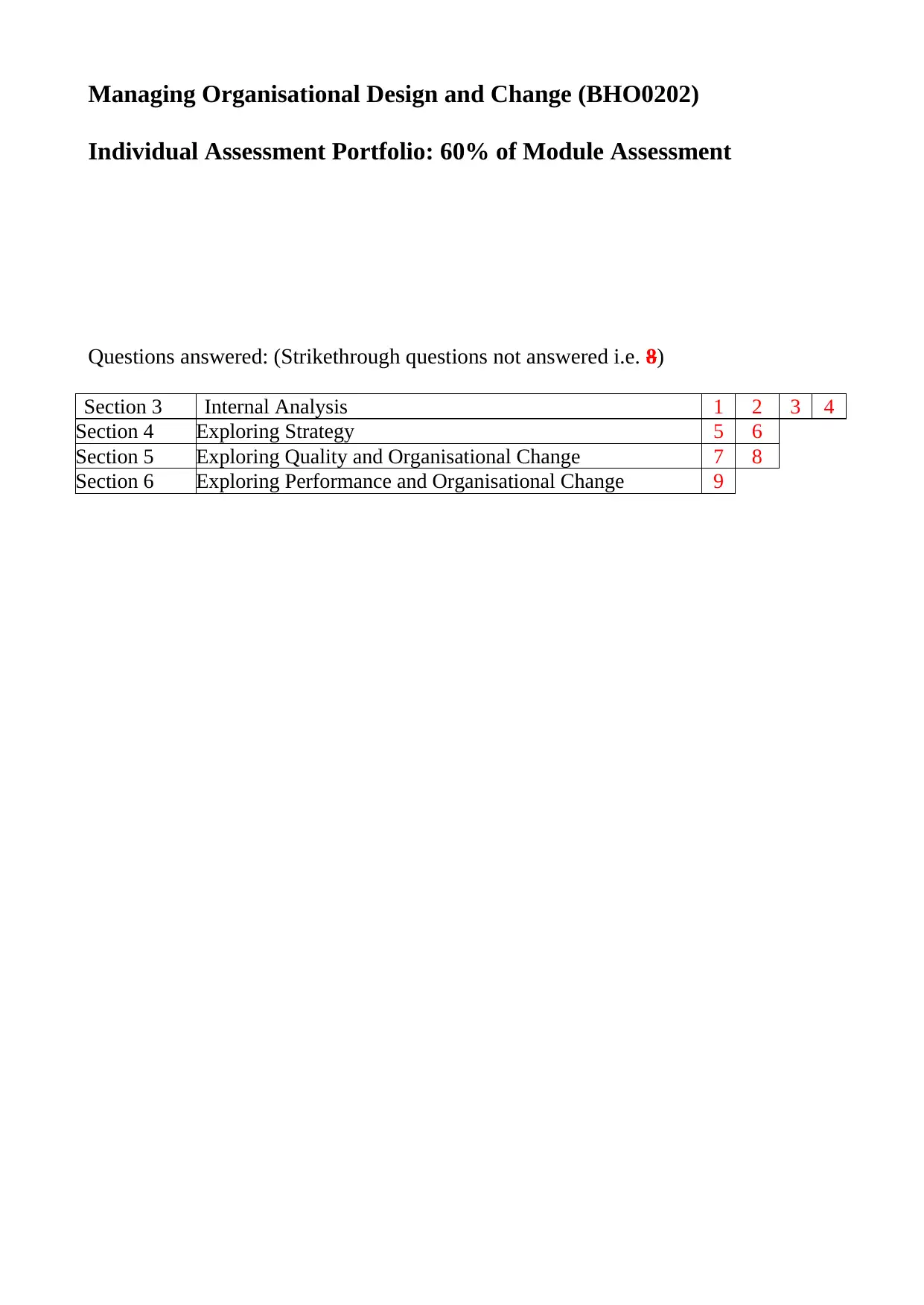
Managing Organisational Design and Change (BHO0202)
Individual Assessment Portfolio: 60% of Module Assessment
Questions answered: (Strikethrough questions not answered i.e. 8)
Section 3 Internal Analysis 1 2 3 4
Section 4 Exploring Strategy 5 6
Section 5 Exploring Quality and Organisational Change 7 8
Section 6 Exploring Performance and Organisational Change 9
Individual Assessment Portfolio: 60% of Module Assessment
Questions answered: (Strikethrough questions not answered i.e. 8)
Section 3 Internal Analysis 1 2 3 4
Section 4 Exploring Strategy 5 6
Section 5 Exploring Quality and Organisational Change 7 8
Section 6 Exploring Performance and Organisational Change 9
Secure Best Marks with AI Grader
Need help grading? Try our AI Grader for instant feedback on your assignments.
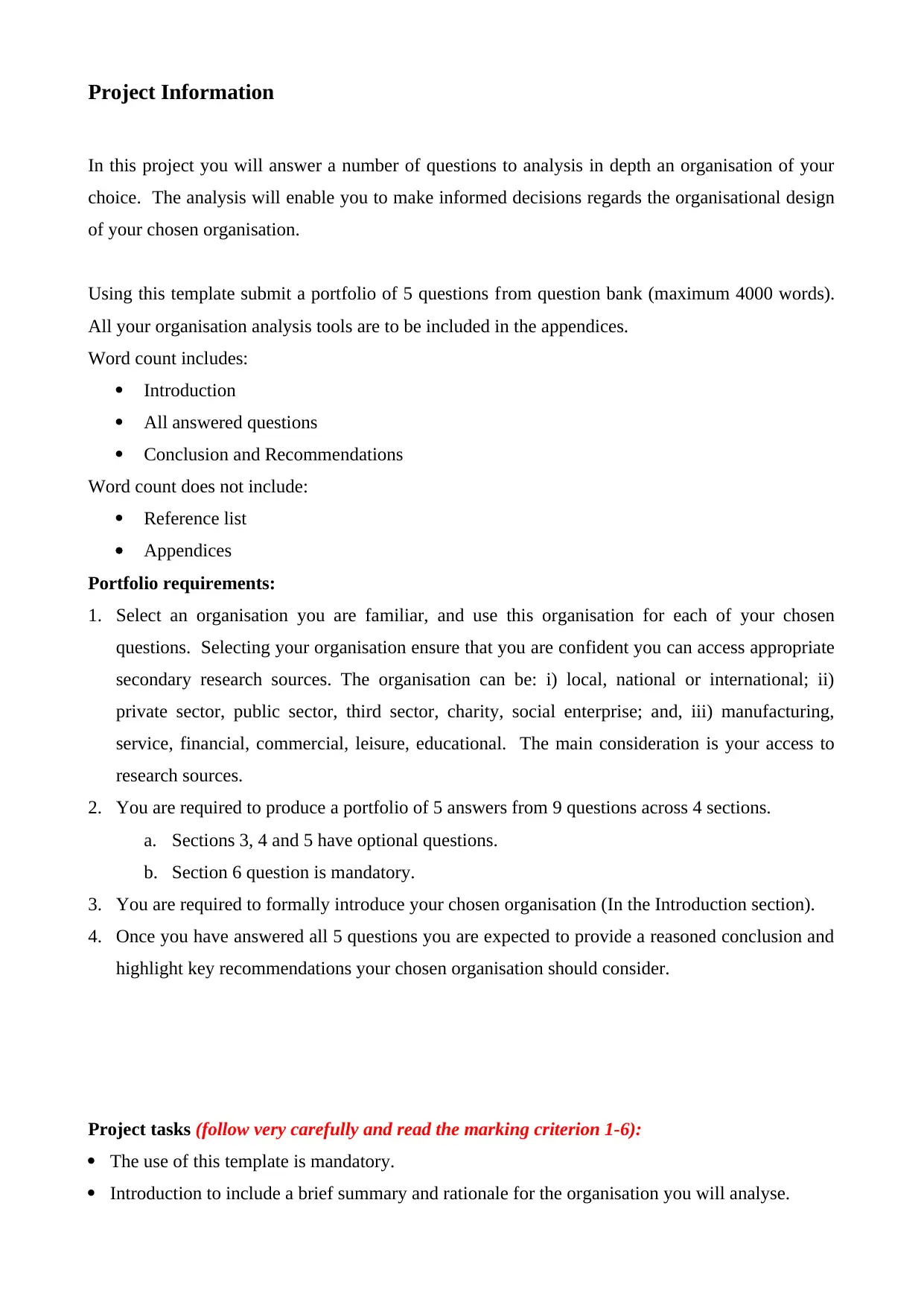
Project Information
In this project you will answer a number of questions to analysis in depth an organisation of your
choice. The analysis will enable you to make informed decisions regards the organisational design
of your chosen organisation.
Using this template submit a portfolio of 5 questions from question bank (maximum 4000 words).
All your organisation analysis tools are to be included in the appendices.
Word count includes:
Introduction
All answered questions
Conclusion and Recommendations
Word count does not include:
Reference list
Appendices
Portfolio requirements:
1. Select an organisation you are familiar, and use this organisation for each of your chosen
questions. Selecting your organisation ensure that you are confident you can access appropriate
secondary research sources. The organisation can be: i) local, national or international; ii)
private sector, public sector, third sector, charity, social enterprise; and, iii) manufacturing,
service, financial, commercial, leisure, educational. The main consideration is your access to
research sources.
2. You are required to produce a portfolio of 5 answers from 9 questions across 4 sections.
a. Sections 3, 4 and 5 have optional questions.
b. Section 6 question is mandatory.
3. You are required to formally introduce your chosen organisation (In the Introduction section).
4. Once you have answered all 5 questions you are expected to provide a reasoned conclusion and
highlight key recommendations your chosen organisation should consider.
Project tasks (follow very carefully and read the marking criterion 1-6):
The use of this template is mandatory.
Introduction to include a brief summary and rationale for the organisation you will analyse.
In this project you will answer a number of questions to analysis in depth an organisation of your
choice. The analysis will enable you to make informed decisions regards the organisational design
of your chosen organisation.
Using this template submit a portfolio of 5 questions from question bank (maximum 4000 words).
All your organisation analysis tools are to be included in the appendices.
Word count includes:
Introduction
All answered questions
Conclusion and Recommendations
Word count does not include:
Reference list
Appendices
Portfolio requirements:
1. Select an organisation you are familiar, and use this organisation for each of your chosen
questions. Selecting your organisation ensure that you are confident you can access appropriate
secondary research sources. The organisation can be: i) local, national or international; ii)
private sector, public sector, third sector, charity, social enterprise; and, iii) manufacturing,
service, financial, commercial, leisure, educational. The main consideration is your access to
research sources.
2. You are required to produce a portfolio of 5 answers from 9 questions across 4 sections.
a. Sections 3, 4 and 5 have optional questions.
b. Section 6 question is mandatory.
3. You are required to formally introduce your chosen organisation (In the Introduction section).
4. Once you have answered all 5 questions you are expected to provide a reasoned conclusion and
highlight key recommendations your chosen organisation should consider.
Project tasks (follow very carefully and read the marking criterion 1-6):
The use of this template is mandatory.
Introduction to include a brief summary and rationale for the organisation you will analyse.
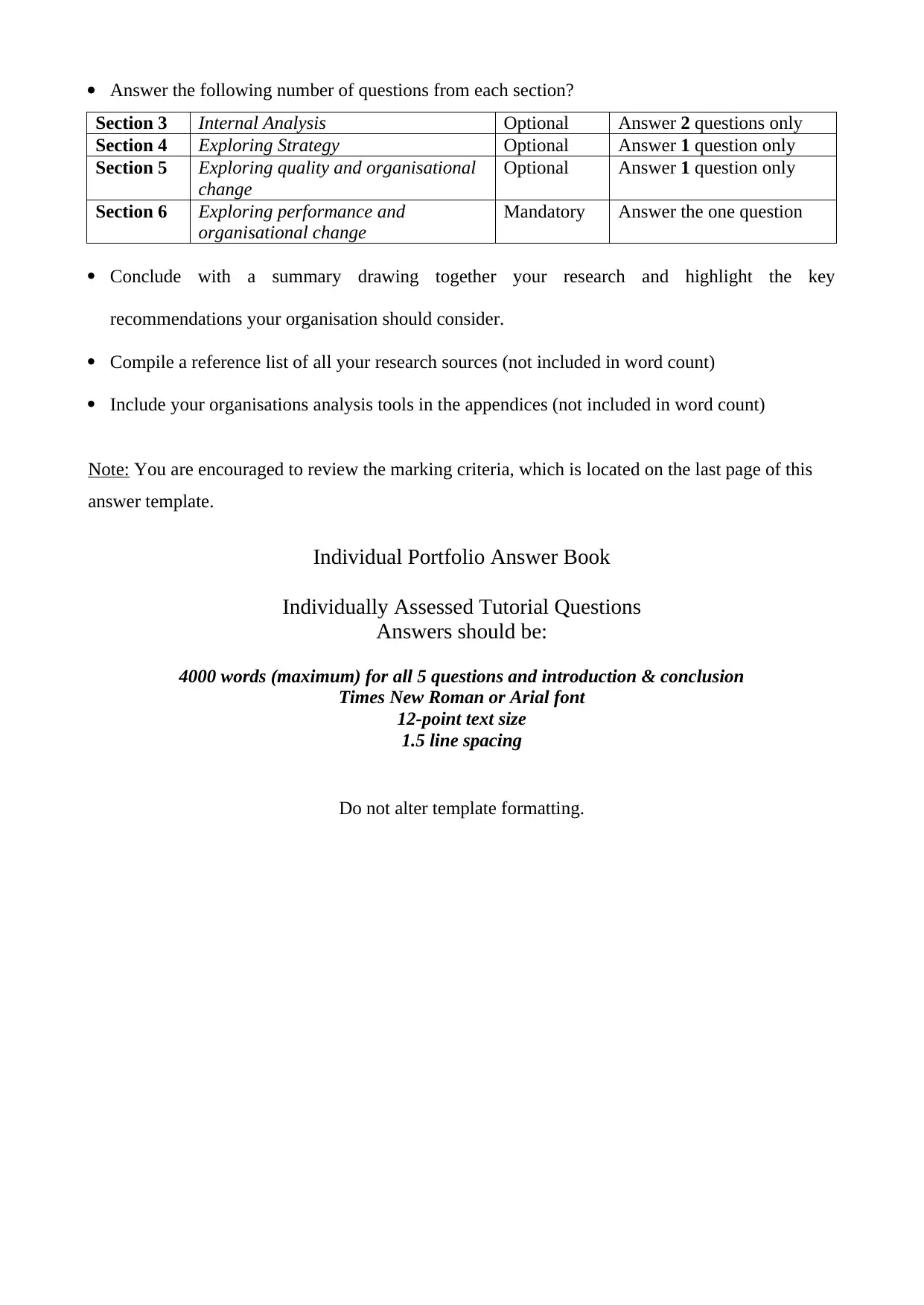
Answer the following number of questions from each section?
Section 3 Internal Analysis Optional Answer 2 questions only
Section 4 Exploring Strategy Optional Answer 1 question only
Section 5 Exploring quality and organisational
change
Optional Answer 1 question only
Section 6 Exploring performance and
organisational change
Mandatory Answer the one question
Conclude with a summary drawing together your research and highlight the key
recommendations your organisation should consider.
Compile a reference list of all your research sources (not included in word count)
Include your organisations analysis tools in the appendices (not included in word count)
Note: You are encouraged to review the marking criteria, which is located on the last page of this
answer template.
Individual Portfolio Answer Book
Individually Assessed Tutorial Questions
Answers should be:
4000 words (maximum) for all 5 questions and introduction & conclusion
Times New Roman or Arial font
12-point text size
1.5 line spacing
Do not alter template formatting.
Section 3 Internal Analysis Optional Answer 2 questions only
Section 4 Exploring Strategy Optional Answer 1 question only
Section 5 Exploring quality and organisational
change
Optional Answer 1 question only
Section 6 Exploring performance and
organisational change
Mandatory Answer the one question
Conclude with a summary drawing together your research and highlight the key
recommendations your organisation should consider.
Compile a reference list of all your research sources (not included in word count)
Include your organisations analysis tools in the appendices (not included in word count)
Note: You are encouraged to review the marking criteria, which is located on the last page of this
answer template.
Individual Portfolio Answer Book
Individually Assessed Tutorial Questions
Answers should be:
4000 words (maximum) for all 5 questions and introduction & conclusion
Times New Roman or Arial font
12-point text size
1.5 line spacing
Do not alter template formatting.
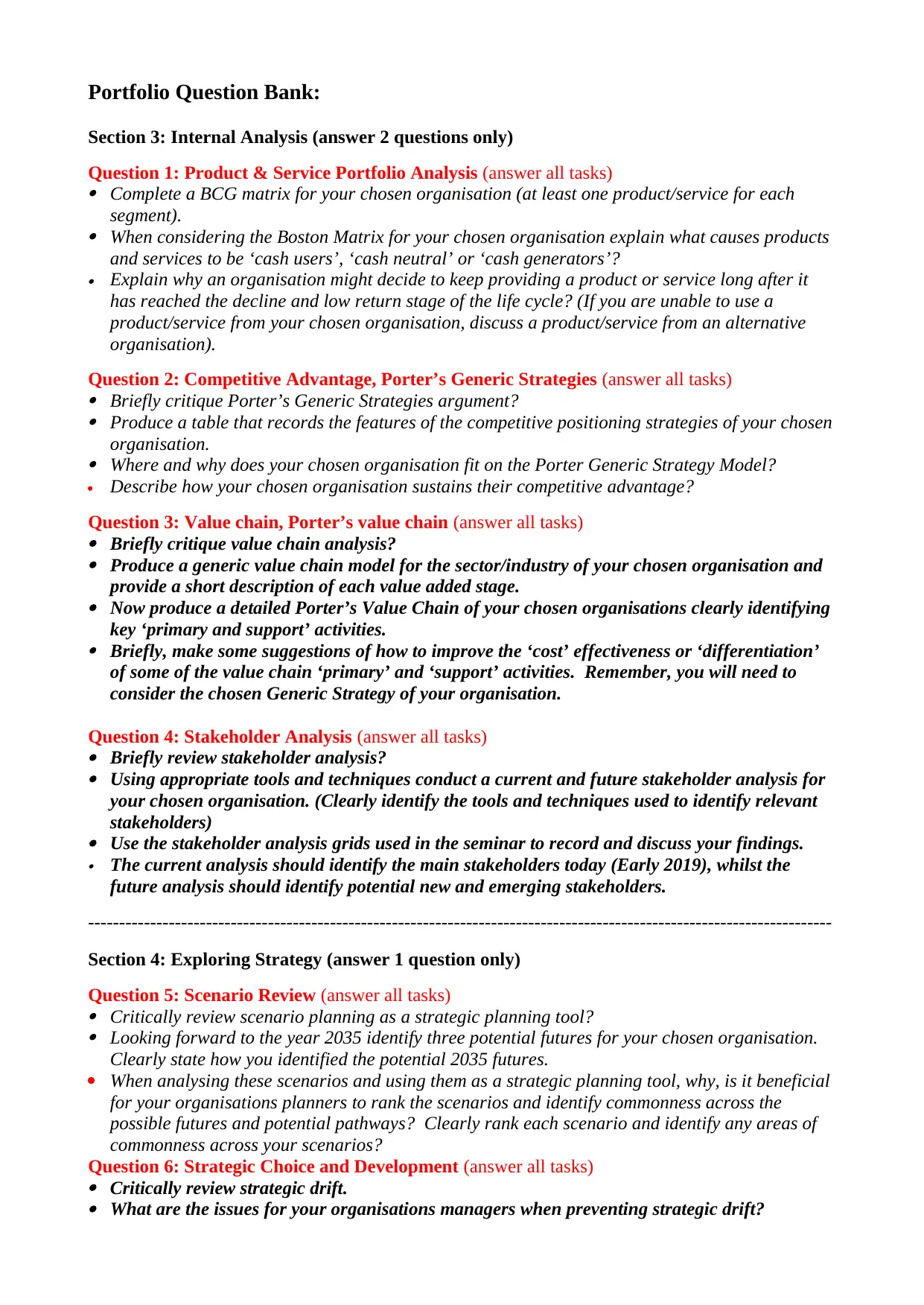
Portfolio Question Bank:
Section 3: Internal Analysis (answer 2 questions only)
Question 1: Product & Service Portfolio Analysis (answer all tasks) Complete a BCG matrix for your chosen organisation (at least one product/service for each
segment). When considering the Boston Matrix for your chosen organisation explain what causes products
and services to be ‘cash users’, ‘cash neutral’ or ‘cash generators’? Explain why an organisation might decide to keep providing a product or service long after it
has reached the decline and low return stage of the life cycle? (If you are unable to use a
product/service from your chosen organisation, discuss a product/service from an alternative
organisation).
Question 2: Competitive Advantage, Porter’s Generic Strategies (answer all tasks) Briefly critique Porter’s Generic Strategies argument? Produce a table that records the features of the competitive positioning strategies of your chosen
organisation. Where and why does your chosen organisation fit on the Porter Generic Strategy Model?
Describe how your chosen organisation sustains their competitive advantage?
Question 3: Value chain, Porter’s value chain (answer all tasks) Briefly critique value chain analysis? Produce a generic value chain model for the sector/industry of your chosen organisation and
provide a short description of each value added stage. Now produce a detailed Porter’s Value Chain of your chosen organisations clearly identifying
key ‘primary and support’ activities. Briefly, make some suggestions of how to improve the ‘cost’ effectiveness or ‘differentiation’
of some of the value chain ‘primary’ and ‘support’ activities. Remember, you will need to
consider the chosen Generic Strategy of your organisation.
Question 4: Stakeholder Analysis (answer all tasks) Briefly review stakeholder analysis? Using appropriate tools and techniques conduct a current and future stakeholder analysis for
your chosen organisation. (Clearly identify the tools and techniques used to identify relevant
stakeholders) Use the stakeholder analysis grids used in the seminar to record and discuss your findings. The current analysis should identify the main stakeholders today (Early 2019), whilst the
future analysis should identify potential new and emerging stakeholders.
------------------------------------------------------------------------------------------------------------------------
Section 4: Exploring Strategy (answer 1 question only)
Question 5: Scenario Review (answer all tasks) Critically review scenario planning as a strategic planning tool? Looking forward to the year 2035 identify three potential futures for your chosen organisation.
Clearly state how you identified the potential 2035 futures.
When analysing these scenarios and using them as a strategic planning tool, why, is it beneficial
for your organisations planners to rank the scenarios and identify commonness across the
possible futures and potential pathways? Clearly rank each scenario and identify any areas of
commonness across your scenarios?
Question 6: Strategic Choice and Development (answer all tasks) Critically review strategic drift. What are the issues for your organisations managers when preventing strategic drift?
Section 3: Internal Analysis (answer 2 questions only)
Question 1: Product & Service Portfolio Analysis (answer all tasks) Complete a BCG matrix for your chosen organisation (at least one product/service for each
segment). When considering the Boston Matrix for your chosen organisation explain what causes products
and services to be ‘cash users’, ‘cash neutral’ or ‘cash generators’? Explain why an organisation might decide to keep providing a product or service long after it
has reached the decline and low return stage of the life cycle? (If you are unable to use a
product/service from your chosen organisation, discuss a product/service from an alternative
organisation).
Question 2: Competitive Advantage, Porter’s Generic Strategies (answer all tasks) Briefly critique Porter’s Generic Strategies argument? Produce a table that records the features of the competitive positioning strategies of your chosen
organisation. Where and why does your chosen organisation fit on the Porter Generic Strategy Model?
Describe how your chosen organisation sustains their competitive advantage?
Question 3: Value chain, Porter’s value chain (answer all tasks) Briefly critique value chain analysis? Produce a generic value chain model for the sector/industry of your chosen organisation and
provide a short description of each value added stage. Now produce a detailed Porter’s Value Chain of your chosen organisations clearly identifying
key ‘primary and support’ activities. Briefly, make some suggestions of how to improve the ‘cost’ effectiveness or ‘differentiation’
of some of the value chain ‘primary’ and ‘support’ activities. Remember, you will need to
consider the chosen Generic Strategy of your organisation.
Question 4: Stakeholder Analysis (answer all tasks) Briefly review stakeholder analysis? Using appropriate tools and techniques conduct a current and future stakeholder analysis for
your chosen organisation. (Clearly identify the tools and techniques used to identify relevant
stakeholders) Use the stakeholder analysis grids used in the seminar to record and discuss your findings. The current analysis should identify the main stakeholders today (Early 2019), whilst the
future analysis should identify potential new and emerging stakeholders.
------------------------------------------------------------------------------------------------------------------------
Section 4: Exploring Strategy (answer 1 question only)
Question 5: Scenario Review (answer all tasks) Critically review scenario planning as a strategic planning tool? Looking forward to the year 2035 identify three potential futures for your chosen organisation.
Clearly state how you identified the potential 2035 futures.
When analysing these scenarios and using them as a strategic planning tool, why, is it beneficial
for your organisations planners to rank the scenarios and identify commonness across the
possible futures and potential pathways? Clearly rank each scenario and identify any areas of
commonness across your scenarios?
Question 6: Strategic Choice and Development (answer all tasks) Critically review strategic drift. What are the issues for your organisations managers when preventing strategic drift?
Paraphrase This Document
Need a fresh take? Get an instant paraphrase of this document with our AI Paraphraser

Suggest how your organisation can avoid strategic drift?
------------------------------------------------------------------------------------------------------------------------
Section 5: Exploring Quality and Organisational Change (answer 1 question only)
Question 7: Quality Performance and Organisational Change (answer all tasks)
Research on Quality:
• Research the academic literature to find an article or paper that describes how a company
(in your organisation’s sector/industry) uses one (or more) of the quality frameworks,
concepts, tools or techniques.
• Write a summary of the article or paper and critically comment on it.
• Briefly discuss how the key points from the article or paper can be designed into your
organisation, highlighting any interrelated impacts (here consider the McKinsey 7S
framework).
Question 8: Quality Gurus (answer all tasks)
Quality gurus: After conducting a review of literature provide a brief summary concerning the collective work
of the quality gurus we discussed in the seminar. Then select one of the gurus, and provide a more detailed review of their work, paying particular
attention to the relevance of their work on the quality of products and services today and the
performance of the organisations that provide these products and services. Now, discuss how the key contributions of the quality guru can be integrated within the design of
your chosen organisation.
------------------------------------------------------------------------------------------------------------------------
Section 6: Exploring Performance and Organisational Change (answer all question tasks)
Question 9: Performance Management Systems and the Balanced Score Card
After conducting a review of the academic literature concerning Performance Management and
the Balanced Score Card: Answer the following questions and discuss the issues. What is performance management? What is the Balanced Scorecard? Why is Balance Scorecard different to traditional performance management systems? Suggest how your organisation can apply the Balanced Score Card Framework to improve
organisational performance?
Note: To correctly answer the last task you will need to provide at least one example for each
perspective (objective, target, measure, and initiative)
------------------------------------------------------------------------------------------------------------------------
End of Portfolio Question Bank
------------------------------------------------------------------------------------------------------------------------
Section 5: Exploring Quality and Organisational Change (answer 1 question only)
Question 7: Quality Performance and Organisational Change (answer all tasks)
Research on Quality:
• Research the academic literature to find an article or paper that describes how a company
(in your organisation’s sector/industry) uses one (or more) of the quality frameworks,
concepts, tools or techniques.
• Write a summary of the article or paper and critically comment on it.
• Briefly discuss how the key points from the article or paper can be designed into your
organisation, highlighting any interrelated impacts (here consider the McKinsey 7S
framework).
Question 8: Quality Gurus (answer all tasks)
Quality gurus: After conducting a review of literature provide a brief summary concerning the collective work
of the quality gurus we discussed in the seminar. Then select one of the gurus, and provide a more detailed review of their work, paying particular
attention to the relevance of their work on the quality of products and services today and the
performance of the organisations that provide these products and services. Now, discuss how the key contributions of the quality guru can be integrated within the design of
your chosen organisation.
------------------------------------------------------------------------------------------------------------------------
Section 6: Exploring Performance and Organisational Change (answer all question tasks)
Question 9: Performance Management Systems and the Balanced Score Card
After conducting a review of the academic literature concerning Performance Management and
the Balanced Score Card: Answer the following questions and discuss the issues. What is performance management? What is the Balanced Scorecard? Why is Balance Scorecard different to traditional performance management systems? Suggest how your organisation can apply the Balanced Score Card Framework to improve
organisational performance?
Note: To correctly answer the last task you will need to provide at least one example for each
perspective (objective, target, measure, and initiative)
------------------------------------------------------------------------------------------------------------------------
End of Portfolio Question Bank
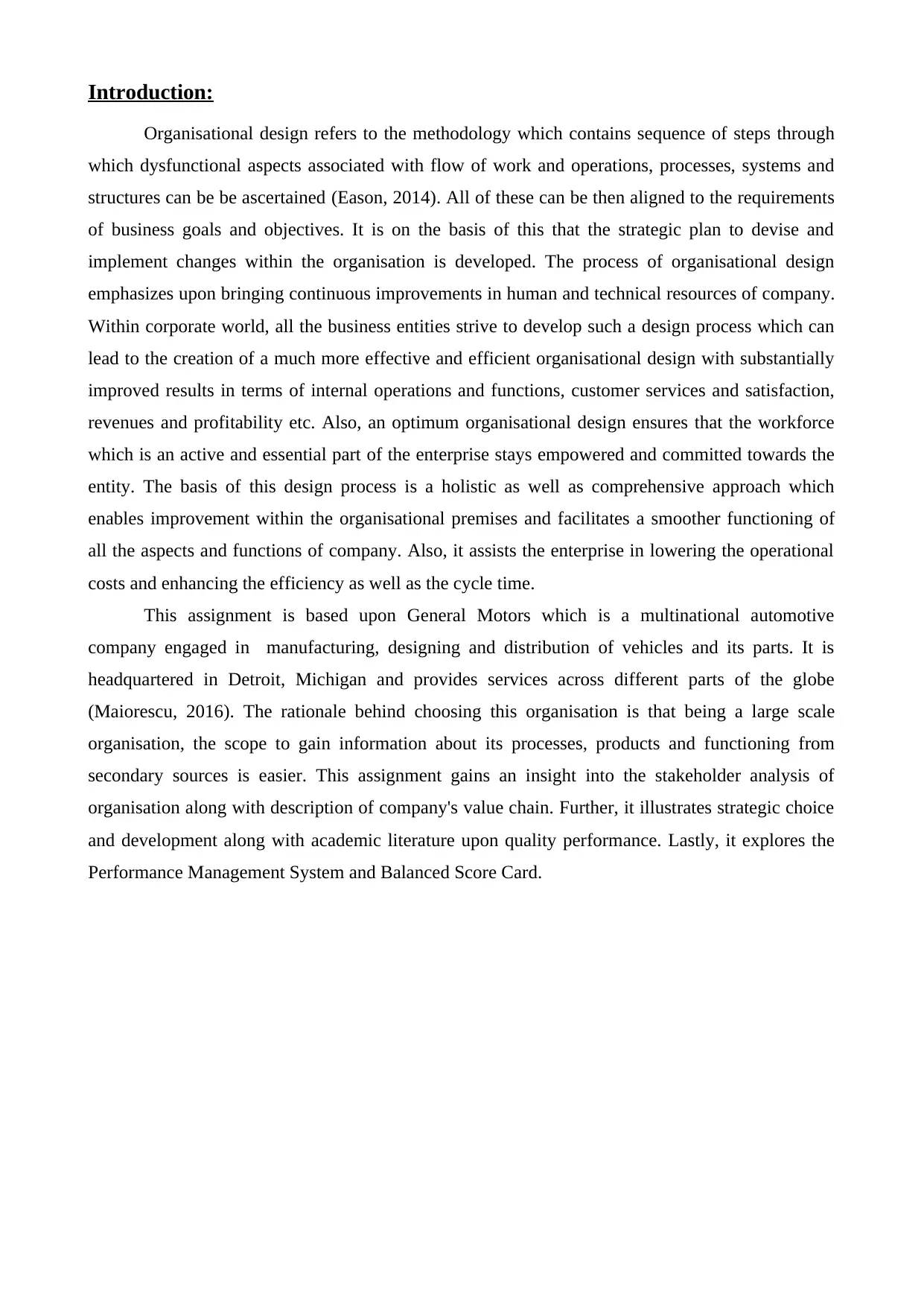
Introduction:
Organisational design refers to the methodology which contains sequence of steps through
which dysfunctional aspects associated with flow of work and operations, processes, systems and
structures can be be ascertained (Eason, 2014). All of these can be then aligned to the requirements
of business goals and objectives. It is on the basis of this that the strategic plan to devise and
implement changes within the organisation is developed. The process of organisational design
emphasizes upon bringing continuous improvements in human and technical resources of company.
Within corporate world, all the business entities strive to develop such a design process which can
lead to the creation of a much more effective and efficient organisational design with substantially
improved results in terms of internal operations and functions, customer services and satisfaction,
revenues and profitability etc. Also, an optimum organisational design ensures that the workforce
which is an active and essential part of the enterprise stays empowered and committed towards the
entity. The basis of this design process is a holistic as well as comprehensive approach which
enables improvement within the organisational premises and facilitates a smoother functioning of
all the aspects and functions of company. Also, it assists the enterprise in lowering the operational
costs and enhancing the efficiency as well as the cycle time.
This assignment is based upon General Motors which is a multinational automotive
company engaged in manufacturing, designing and distribution of vehicles and its parts. It is
headquartered in Detroit, Michigan and provides services across different parts of the globe
(Maiorescu, 2016). The rationale behind choosing this organisation is that being a large scale
organisation, the scope to gain information about its processes, products and functioning from
secondary sources is easier. This assignment gains an insight into the stakeholder analysis of
organisation along with description of company's value chain. Further, it illustrates strategic choice
and development along with academic literature upon quality performance. Lastly, it explores the
Performance Management System and Balanced Score Card.
Organisational design refers to the methodology which contains sequence of steps through
which dysfunctional aspects associated with flow of work and operations, processes, systems and
structures can be be ascertained (Eason, 2014). All of these can be then aligned to the requirements
of business goals and objectives. It is on the basis of this that the strategic plan to devise and
implement changes within the organisation is developed. The process of organisational design
emphasizes upon bringing continuous improvements in human and technical resources of company.
Within corporate world, all the business entities strive to develop such a design process which can
lead to the creation of a much more effective and efficient organisational design with substantially
improved results in terms of internal operations and functions, customer services and satisfaction,
revenues and profitability etc. Also, an optimum organisational design ensures that the workforce
which is an active and essential part of the enterprise stays empowered and committed towards the
entity. The basis of this design process is a holistic as well as comprehensive approach which
enables improvement within the organisational premises and facilitates a smoother functioning of
all the aspects and functions of company. Also, it assists the enterprise in lowering the operational
costs and enhancing the efficiency as well as the cycle time.
This assignment is based upon General Motors which is a multinational automotive
company engaged in manufacturing, designing and distribution of vehicles and its parts. It is
headquartered in Detroit, Michigan and provides services across different parts of the globe
(Maiorescu, 2016). The rationale behind choosing this organisation is that being a large scale
organisation, the scope to gain information about its processes, products and functioning from
secondary sources is easier. This assignment gains an insight into the stakeholder analysis of
organisation along with description of company's value chain. Further, it illustrates strategic choice
and development along with academic literature upon quality performance. Lastly, it explores the
Performance Management System and Balanced Score Card.
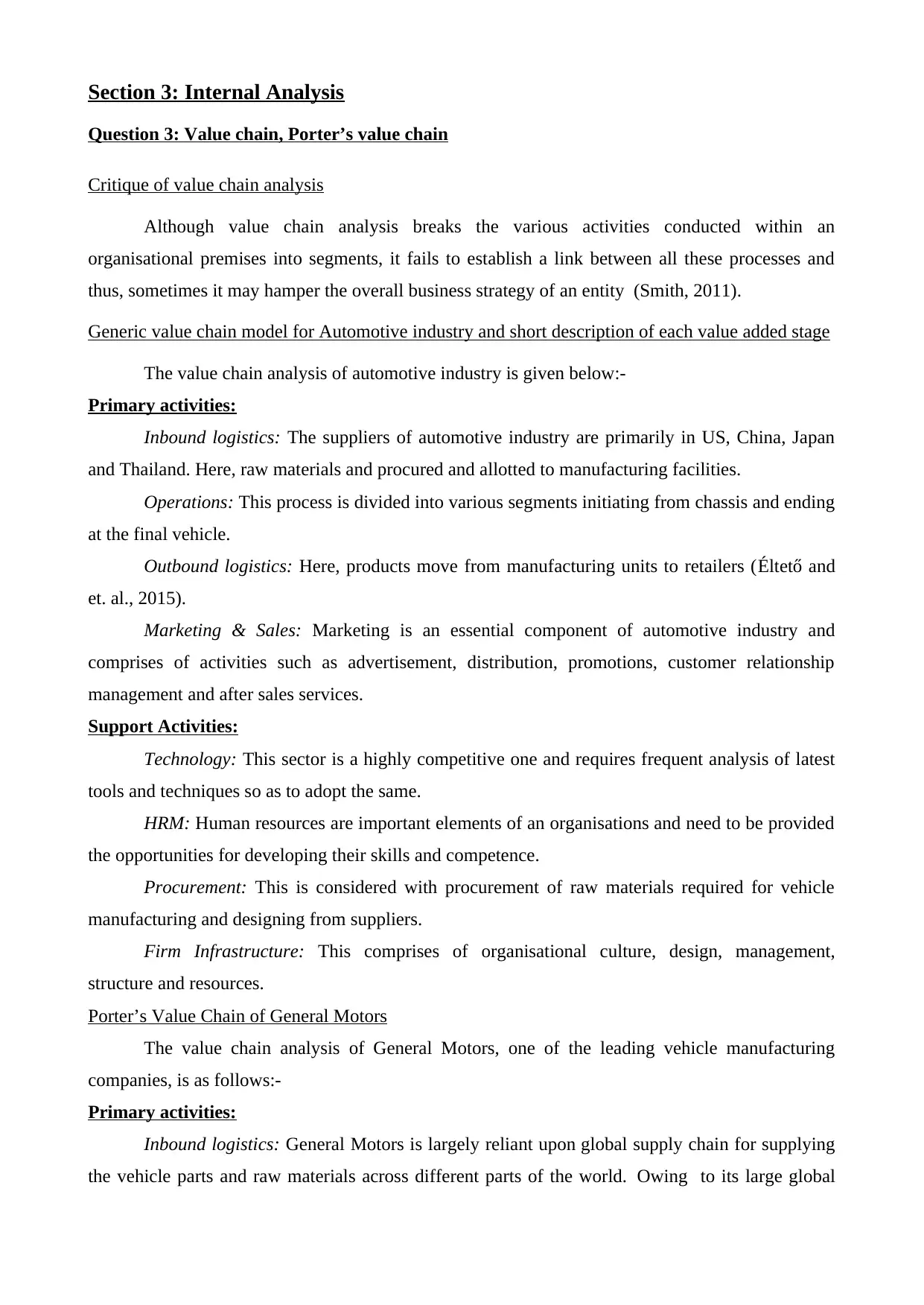
Section 3: Internal Analysis
Question 3: Value chain, Porter’s value chain
Critique of value chain analysis
Although value chain analysis breaks the various activities conducted within an
organisational premises into segments, it fails to establish a link between all these processes and
thus, sometimes it may hamper the overall business strategy of an entity (Smith, 2011).
Generic value chain model for Automotive industry and short description of each value added stage
The value chain analysis of automotive industry is given below:-
Primary activities:
Inbound logistics: The suppliers of automotive industry are primarily in US, China, Japan
and Thailand. Here, raw materials and procured and allotted to manufacturing facilities.
Operations: This process is divided into various segments initiating from chassis and ending
at the final vehicle.
Outbound logistics: Here, products move from manufacturing units to retailers (Éltető and
et. al., 2015).
Marketing & Sales: Marketing is an essential component of automotive industry and
comprises of activities such as advertisement, distribution, promotions, customer relationship
management and after sales services.
Support Activities:
Technology: This sector is a highly competitive one and requires frequent analysis of latest
tools and techniques so as to adopt the same.
HRM: Human resources are important elements of an organisations and need to be provided
the opportunities for developing their skills and competence.
Procurement: This is considered with procurement of raw materials required for vehicle
manufacturing and designing from suppliers.
Firm Infrastructure: This comprises of organisational culture, design, management,
structure and resources.
Porter’s Value Chain of General Motors
The value chain analysis of General Motors, one of the leading vehicle manufacturing
companies, is as follows:-
Primary activities:
Inbound logistics: General Motors is largely reliant upon global supply chain for supplying
the vehicle parts and raw materials across different parts of the world. Owing to its large global
Question 3: Value chain, Porter’s value chain
Critique of value chain analysis
Although value chain analysis breaks the various activities conducted within an
organisational premises into segments, it fails to establish a link between all these processes and
thus, sometimes it may hamper the overall business strategy of an entity (Smith, 2011).
Generic value chain model for Automotive industry and short description of each value added stage
The value chain analysis of automotive industry is given below:-
Primary activities:
Inbound logistics: The suppliers of automotive industry are primarily in US, China, Japan
and Thailand. Here, raw materials and procured and allotted to manufacturing facilities.
Operations: This process is divided into various segments initiating from chassis and ending
at the final vehicle.
Outbound logistics: Here, products move from manufacturing units to retailers (Éltető and
et. al., 2015).
Marketing & Sales: Marketing is an essential component of automotive industry and
comprises of activities such as advertisement, distribution, promotions, customer relationship
management and after sales services.
Support Activities:
Technology: This sector is a highly competitive one and requires frequent analysis of latest
tools and techniques so as to adopt the same.
HRM: Human resources are important elements of an organisations and need to be provided
the opportunities for developing their skills and competence.
Procurement: This is considered with procurement of raw materials required for vehicle
manufacturing and designing from suppliers.
Firm Infrastructure: This comprises of organisational culture, design, management,
structure and resources.
Porter’s Value Chain of General Motors
The value chain analysis of General Motors, one of the leading vehicle manufacturing
companies, is as follows:-
Primary activities:
Inbound logistics: General Motors is largely reliant upon global supply chain for supplying
the vehicle parts and raw materials across different parts of the world. Owing to its large global
Secure Best Marks with AI Grader
Need help grading? Try our AI Grader for instant feedback on your assignments.
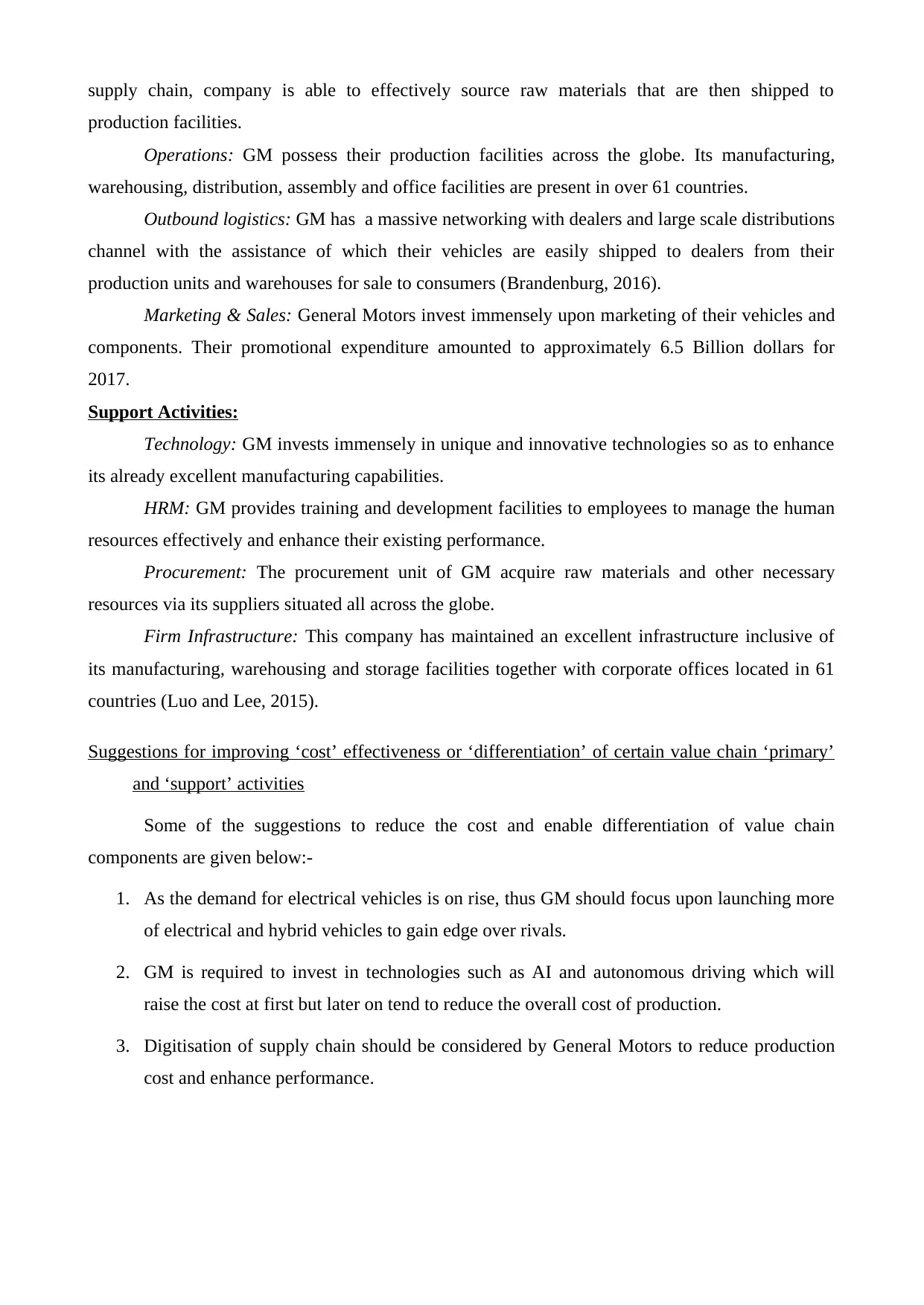
supply chain, company is able to effectively source raw materials that are then shipped to
production facilities.
Operations: GM possess their production facilities across the globe. Its manufacturing,
warehousing, distribution, assembly and office facilities are present in over 61 countries.
Outbound logistics: GM has a massive networking with dealers and large scale distributions
channel with the assistance of which their vehicles are easily shipped to dealers from their
production units and warehouses for sale to consumers (Brandenburg, 2016).
Marketing & Sales: General Motors invest immensely upon marketing of their vehicles and
components. Their promotional expenditure amounted to approximately 6.5 Billion dollars for
2017.
Support Activities:
Technology: GM invests immensely in unique and innovative technologies so as to enhance
its already excellent manufacturing capabilities.
HRM: GM provides training and development facilities to employees to manage the human
resources effectively and enhance their existing performance.
Procurement: The procurement unit of GM acquire raw materials and other necessary
resources via its suppliers situated all across the globe.
Firm Infrastructure: This company has maintained an excellent infrastructure inclusive of
its manufacturing, warehousing and storage facilities together with corporate offices located in 61
countries (Luo and Lee, 2015).
Suggestions for improving ‘cost’ effectiveness or ‘differentiation’ of certain value chain ‘primary’
and ‘support’ activities
Some of the suggestions to reduce the cost and enable differentiation of value chain
components are given below:-
1. As the demand for electrical vehicles is on rise, thus GM should focus upon launching more
of electrical and hybrid vehicles to gain edge over rivals.
2. GM is required to invest in technologies such as AI and autonomous driving which will
raise the cost at first but later on tend to reduce the overall cost of production.
3. Digitisation of supply chain should be considered by General Motors to reduce production
cost and enhance performance.
production facilities.
Operations: GM possess their production facilities across the globe. Its manufacturing,
warehousing, distribution, assembly and office facilities are present in over 61 countries.
Outbound logistics: GM has a massive networking with dealers and large scale distributions
channel with the assistance of which their vehicles are easily shipped to dealers from their
production units and warehouses for sale to consumers (Brandenburg, 2016).
Marketing & Sales: General Motors invest immensely upon marketing of their vehicles and
components. Their promotional expenditure amounted to approximately 6.5 Billion dollars for
2017.
Support Activities:
Technology: GM invests immensely in unique and innovative technologies so as to enhance
its already excellent manufacturing capabilities.
HRM: GM provides training and development facilities to employees to manage the human
resources effectively and enhance their existing performance.
Procurement: The procurement unit of GM acquire raw materials and other necessary
resources via its suppliers situated all across the globe.
Firm Infrastructure: This company has maintained an excellent infrastructure inclusive of
its manufacturing, warehousing and storage facilities together with corporate offices located in 61
countries (Luo and Lee, 2015).
Suggestions for improving ‘cost’ effectiveness or ‘differentiation’ of certain value chain ‘primary’
and ‘support’ activities
Some of the suggestions to reduce the cost and enable differentiation of value chain
components are given below:-
1. As the demand for electrical vehicles is on rise, thus GM should focus upon launching more
of electrical and hybrid vehicles to gain edge over rivals.
2. GM is required to invest in technologies such as AI and autonomous driving which will
raise the cost at first but later on tend to reduce the overall cost of production.
3. Digitisation of supply chain should be considered by General Motors to reduce production
cost and enhance performance.
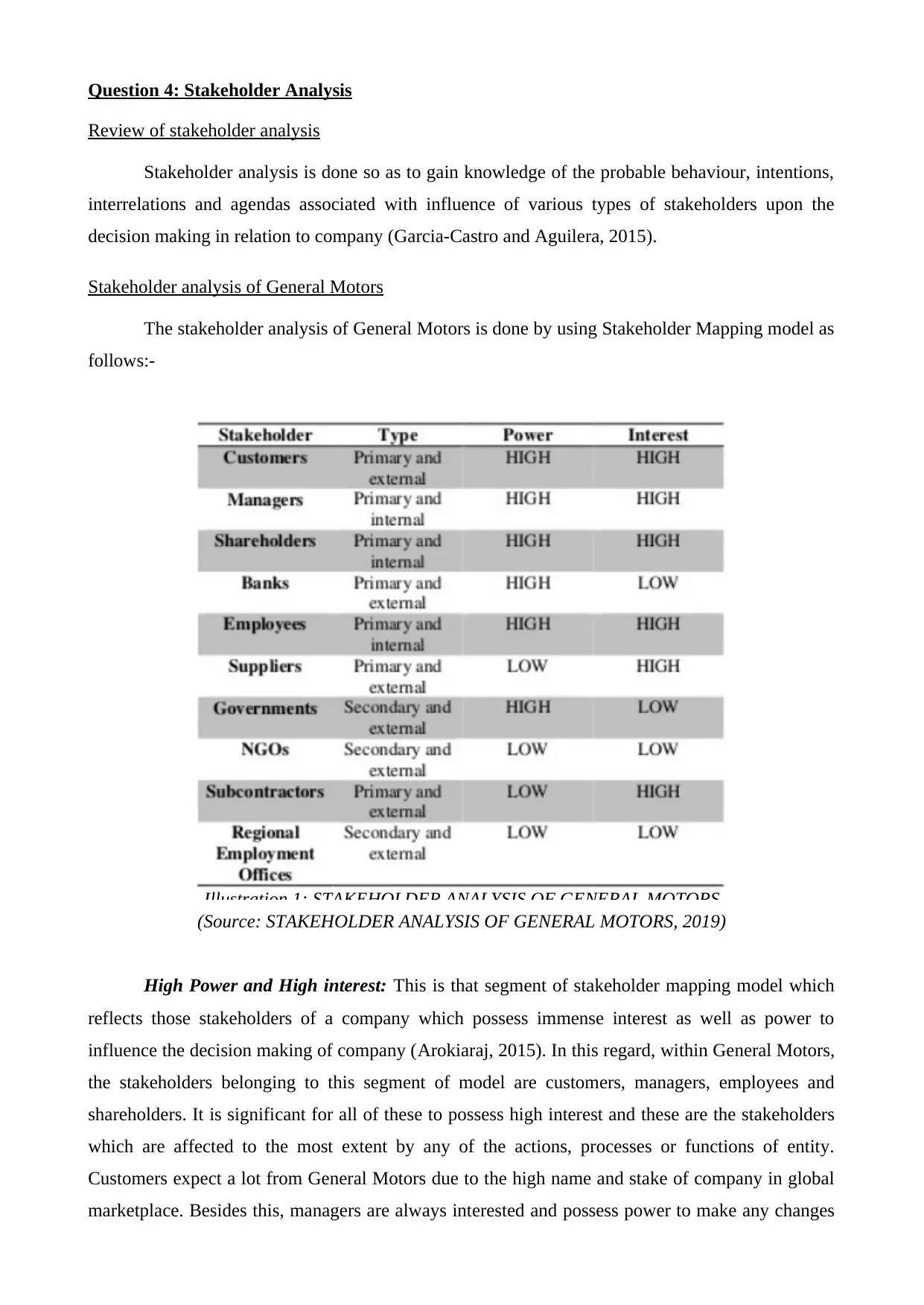
Question 4: Stakeholder Analysis
Review of stakeholder analysis
Stakeholder analysis is done so as to gain knowledge of the probable behaviour, intentions,
interrelations and agendas associated with influence of various types of stakeholders upon the
decision making in relation to company (Garcia‐Castro and Aguilera, 2015).
Stakeholder analysis of General Motors
The stakeholder analysis of General Motors is done by using Stakeholder Mapping model as
follows:-
(Source: STAKEHOLDER ANALYSIS OF GENERAL MOTORS, 2019)
High Power and High interest: This is that segment of stakeholder mapping model which
reflects those stakeholders of a company which possess immense interest as well as power to
influence the decision making of company (Arokiaraj, 2015). In this regard, within General Motors,
the stakeholders belonging to this segment of model are customers, managers, employees and
shareholders. It is significant for all of these to possess high interest and these are the stakeholders
which are affected to the most extent by any of the actions, processes or functions of entity.
Customers expect a lot from General Motors due to the high name and stake of company in global
marketplace. Besides this, managers are always interested and possess power to make any changes
Illustration 1: STAKEHOLDER ANALYSIS OF GENERAL MOTORS
Review of stakeholder analysis
Stakeholder analysis is done so as to gain knowledge of the probable behaviour, intentions,
interrelations and agendas associated with influence of various types of stakeholders upon the
decision making in relation to company (Garcia‐Castro and Aguilera, 2015).
Stakeholder analysis of General Motors
The stakeholder analysis of General Motors is done by using Stakeholder Mapping model as
follows:-
(Source: STAKEHOLDER ANALYSIS OF GENERAL MOTORS, 2019)
High Power and High interest: This is that segment of stakeholder mapping model which
reflects those stakeholders of a company which possess immense interest as well as power to
influence the decision making of company (Arokiaraj, 2015). In this regard, within General Motors,
the stakeholders belonging to this segment of model are customers, managers, employees and
shareholders. It is significant for all of these to possess high interest and these are the stakeholders
which are affected to the most extent by any of the actions, processes or functions of entity.
Customers expect a lot from General Motors due to the high name and stake of company in global
marketplace. Besides this, managers are always interested and possess power to make any changes
Illustration 1: STAKEHOLDER ANALYSIS OF GENERAL MOTORS
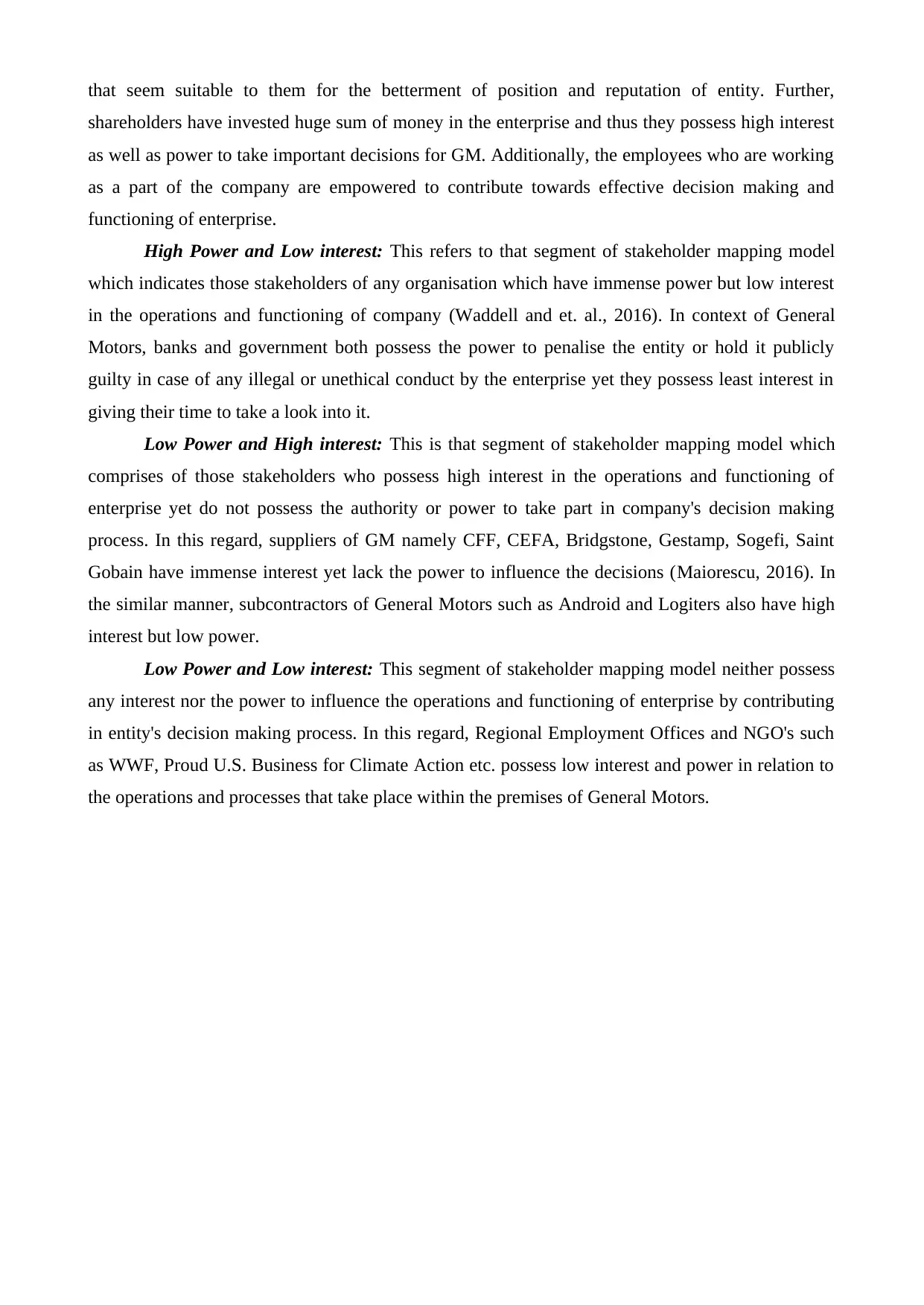
that seem suitable to them for the betterment of position and reputation of entity. Further,
shareholders have invested huge sum of money in the enterprise and thus they possess high interest
as well as power to take important decisions for GM. Additionally, the employees who are working
as a part of the company are empowered to contribute towards effective decision making and
functioning of enterprise.
High Power and Low interest: This refers to that segment of stakeholder mapping model
which indicates those stakeholders of any organisation which have immense power but low interest
in the operations and functioning of company (Waddell and et. al., 2016). In context of General
Motors, banks and government both possess the power to penalise the entity or hold it publicly
guilty in case of any illegal or unethical conduct by the enterprise yet they possess least interest in
giving their time to take a look into it.
Low Power and High interest: This is that segment of stakeholder mapping model which
comprises of those stakeholders who possess high interest in the operations and functioning of
enterprise yet do not possess the authority or power to take part in company's decision making
process. In this regard, suppliers of GM namely CFF, CEFA, Bridgstone, Gestamp, Sogefi, Saint
Gobain have immense interest yet lack the power to influence the decisions (Maiorescu, 2016). In
the similar manner, subcontractors of General Motors such as Android and Logiters also have high
interest but low power.
Low Power and Low interest: This segment of stakeholder mapping model neither possess
any interest nor the power to influence the operations and functioning of enterprise by contributing
in entity's decision making process. In this regard, Regional Employment Offices and NGO's such
as WWF, Proud U.S. Business for Climate Action etc. possess low interest and power in relation to
the operations and processes that take place within the premises of General Motors.
shareholders have invested huge sum of money in the enterprise and thus they possess high interest
as well as power to take important decisions for GM. Additionally, the employees who are working
as a part of the company are empowered to contribute towards effective decision making and
functioning of enterprise.
High Power and Low interest: This refers to that segment of stakeholder mapping model
which indicates those stakeholders of any organisation which have immense power but low interest
in the operations and functioning of company (Waddell and et. al., 2016). In context of General
Motors, banks and government both possess the power to penalise the entity or hold it publicly
guilty in case of any illegal or unethical conduct by the enterprise yet they possess least interest in
giving their time to take a look into it.
Low Power and High interest: This is that segment of stakeholder mapping model which
comprises of those stakeholders who possess high interest in the operations and functioning of
enterprise yet do not possess the authority or power to take part in company's decision making
process. In this regard, suppliers of GM namely CFF, CEFA, Bridgstone, Gestamp, Sogefi, Saint
Gobain have immense interest yet lack the power to influence the decisions (Maiorescu, 2016). In
the similar manner, subcontractors of General Motors such as Android and Logiters also have high
interest but low power.
Low Power and Low interest: This segment of stakeholder mapping model neither possess
any interest nor the power to influence the operations and functioning of enterprise by contributing
in entity's decision making process. In this regard, Regional Employment Offices and NGO's such
as WWF, Proud U.S. Business for Climate Action etc. possess low interest and power in relation to
the operations and processes that take place within the premises of General Motors.
Paraphrase This Document
Need a fresh take? Get an instant paraphrase of this document with our AI Paraphraser
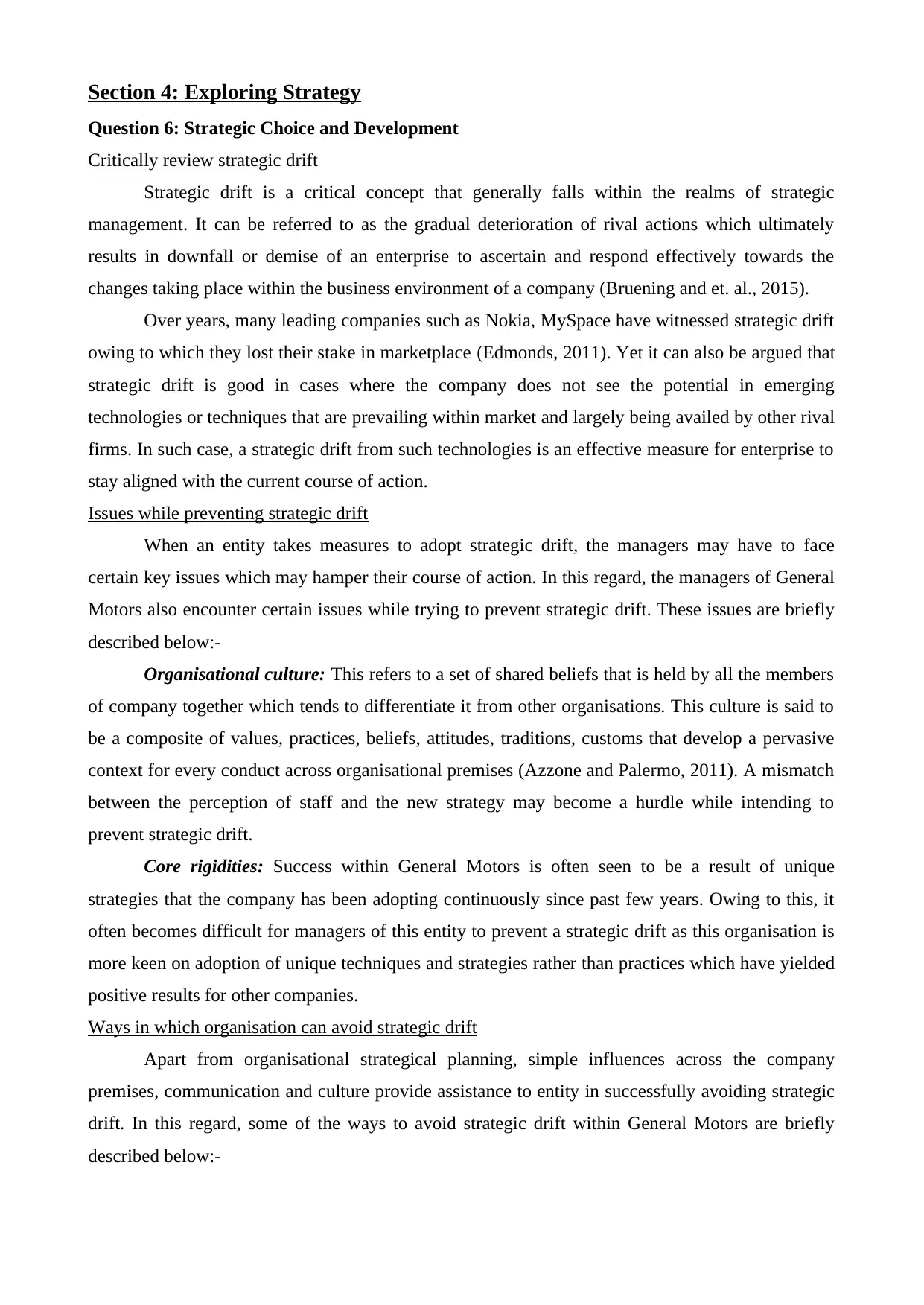
Section 4: Exploring Strategy
Question 6: Strategic Choice and Development
Critically review strategic drift
Strategic drift is a critical concept that generally falls within the realms of strategic
management. It can be referred to as the gradual deterioration of rival actions which ultimately
results in downfall or demise of an enterprise to ascertain and respond effectively towards the
changes taking place within the business environment of a company (Bruening and et. al., 2015).
Over years, many leading companies such as Nokia, MySpace have witnessed strategic drift
owing to which they lost their stake in marketplace (Edmonds, 2011). Yet it can also be argued that
strategic drift is good in cases where the company does not see the potential in emerging
technologies or techniques that are prevailing within market and largely being availed by other rival
firms. In such case, a strategic drift from such technologies is an effective measure for enterprise to
stay aligned with the current course of action.
Issues while preventing strategic drift
When an entity takes measures to adopt strategic drift, the managers may have to face
certain key issues which may hamper their course of action. In this regard, the managers of General
Motors also encounter certain issues while trying to prevent strategic drift. These issues are briefly
described below:-
Organisational culture: This refers to a set of shared beliefs that is held by all the members
of company together which tends to differentiate it from other organisations. This culture is said to
be a composite of values, practices, beliefs, attitudes, traditions, customs that develop a pervasive
context for every conduct across organisational premises (Azzone and Palermo, 2011). A mismatch
between the perception of staff and the new strategy may become a hurdle while intending to
prevent strategic drift.
Core rigidities: Success within General Motors is often seen to be a result of unique
strategies that the company has been adopting continuously since past few years. Owing to this, it
often becomes difficult for managers of this entity to prevent a strategic drift as this organisation is
more keen on adoption of unique techniques and strategies rather than practices which have yielded
positive results for other companies.
Ways in which organisation can avoid strategic drift
Apart from organisational strategical planning, simple influences across the company
premises, communication and culture provide assistance to entity in successfully avoiding strategic
drift. In this regard, some of the ways to avoid strategic drift within General Motors are briefly
described below:-
Question 6: Strategic Choice and Development
Critically review strategic drift
Strategic drift is a critical concept that generally falls within the realms of strategic
management. It can be referred to as the gradual deterioration of rival actions which ultimately
results in downfall or demise of an enterprise to ascertain and respond effectively towards the
changes taking place within the business environment of a company (Bruening and et. al., 2015).
Over years, many leading companies such as Nokia, MySpace have witnessed strategic drift
owing to which they lost their stake in marketplace (Edmonds, 2011). Yet it can also be argued that
strategic drift is good in cases where the company does not see the potential in emerging
technologies or techniques that are prevailing within market and largely being availed by other rival
firms. In such case, a strategic drift from such technologies is an effective measure for enterprise to
stay aligned with the current course of action.
Issues while preventing strategic drift
When an entity takes measures to adopt strategic drift, the managers may have to face
certain key issues which may hamper their course of action. In this regard, the managers of General
Motors also encounter certain issues while trying to prevent strategic drift. These issues are briefly
described below:-
Organisational culture: This refers to a set of shared beliefs that is held by all the members
of company together which tends to differentiate it from other organisations. This culture is said to
be a composite of values, practices, beliefs, attitudes, traditions, customs that develop a pervasive
context for every conduct across organisational premises (Azzone and Palermo, 2011). A mismatch
between the perception of staff and the new strategy may become a hurdle while intending to
prevent strategic drift.
Core rigidities: Success within General Motors is often seen to be a result of unique
strategies that the company has been adopting continuously since past few years. Owing to this, it
often becomes difficult for managers of this entity to prevent a strategic drift as this organisation is
more keen on adoption of unique techniques and strategies rather than practices which have yielded
positive results for other companies.
Ways in which organisation can avoid strategic drift
Apart from organisational strategical planning, simple influences across the company
premises, communication and culture provide assistance to entity in successfully avoiding strategic
drift. In this regard, some of the ways to avoid strategic drift within General Motors are briefly
described below:-
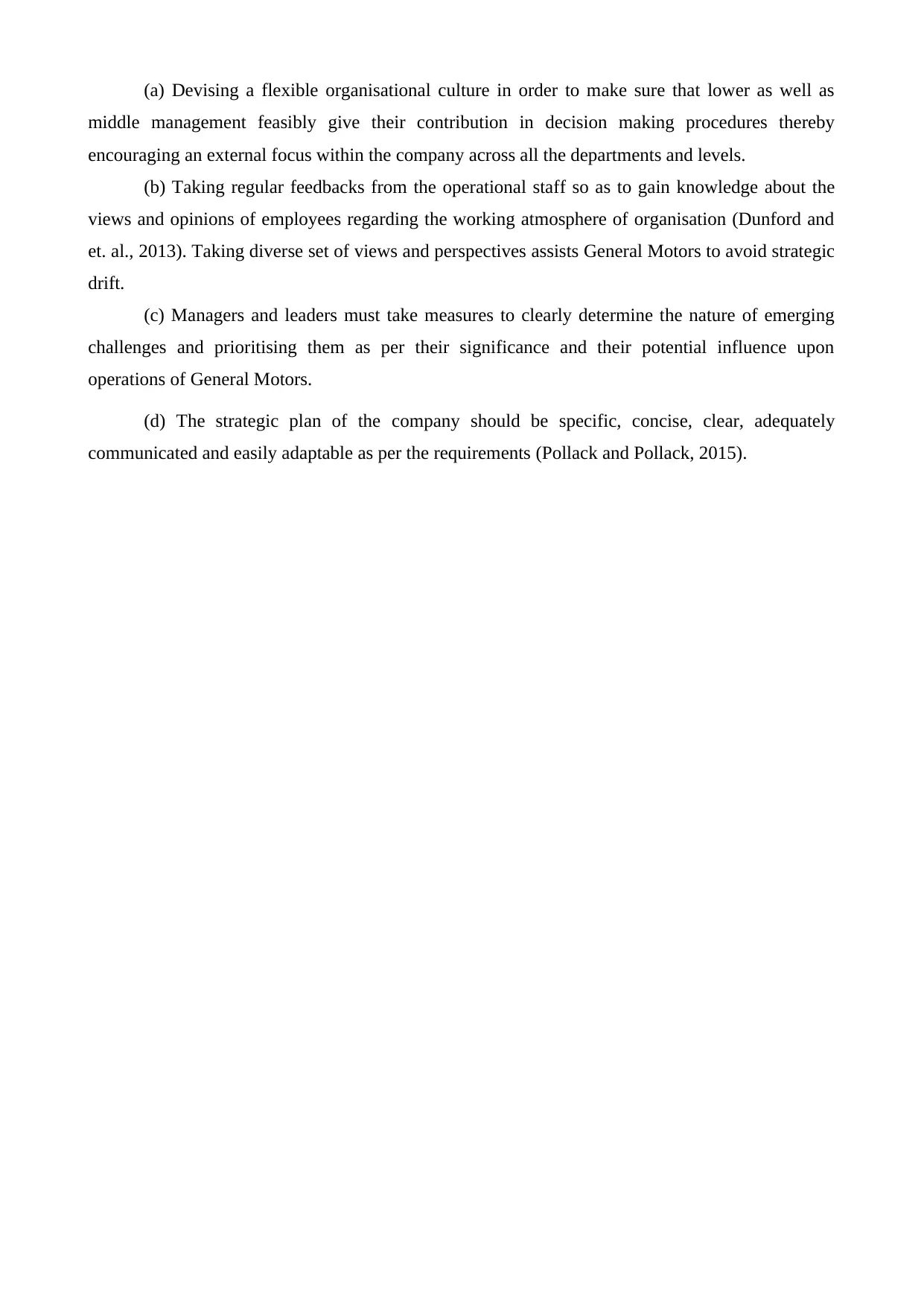
(a) Devising a flexible organisational culture in order to make sure that lower as well as
middle management feasibly give their contribution in decision making procedures thereby
encouraging an external focus within the company across all the departments and levels.
(b) Taking regular feedbacks from the operational staff so as to gain knowledge about the
views and opinions of employees regarding the working atmosphere of organisation (Dunford and
et. al., 2013). Taking diverse set of views and perspectives assists General Motors to avoid strategic
drift.
(c) Managers and leaders must take measures to clearly determine the nature of emerging
challenges and prioritising them as per their significance and their potential influence upon
operations of General Motors.
(d) The strategic plan of the company should be specific, concise, clear, adequately
communicated and easily adaptable as per the requirements (Pollack and Pollack, 2015).
middle management feasibly give their contribution in decision making procedures thereby
encouraging an external focus within the company across all the departments and levels.
(b) Taking regular feedbacks from the operational staff so as to gain knowledge about the
views and opinions of employees regarding the working atmosphere of organisation (Dunford and
et. al., 2013). Taking diverse set of views and perspectives assists General Motors to avoid strategic
drift.
(c) Managers and leaders must take measures to clearly determine the nature of emerging
challenges and prioritising them as per their significance and their potential influence upon
operations of General Motors.
(d) The strategic plan of the company should be specific, concise, clear, adequately
communicated and easily adaptable as per the requirements (Pollack and Pollack, 2015).
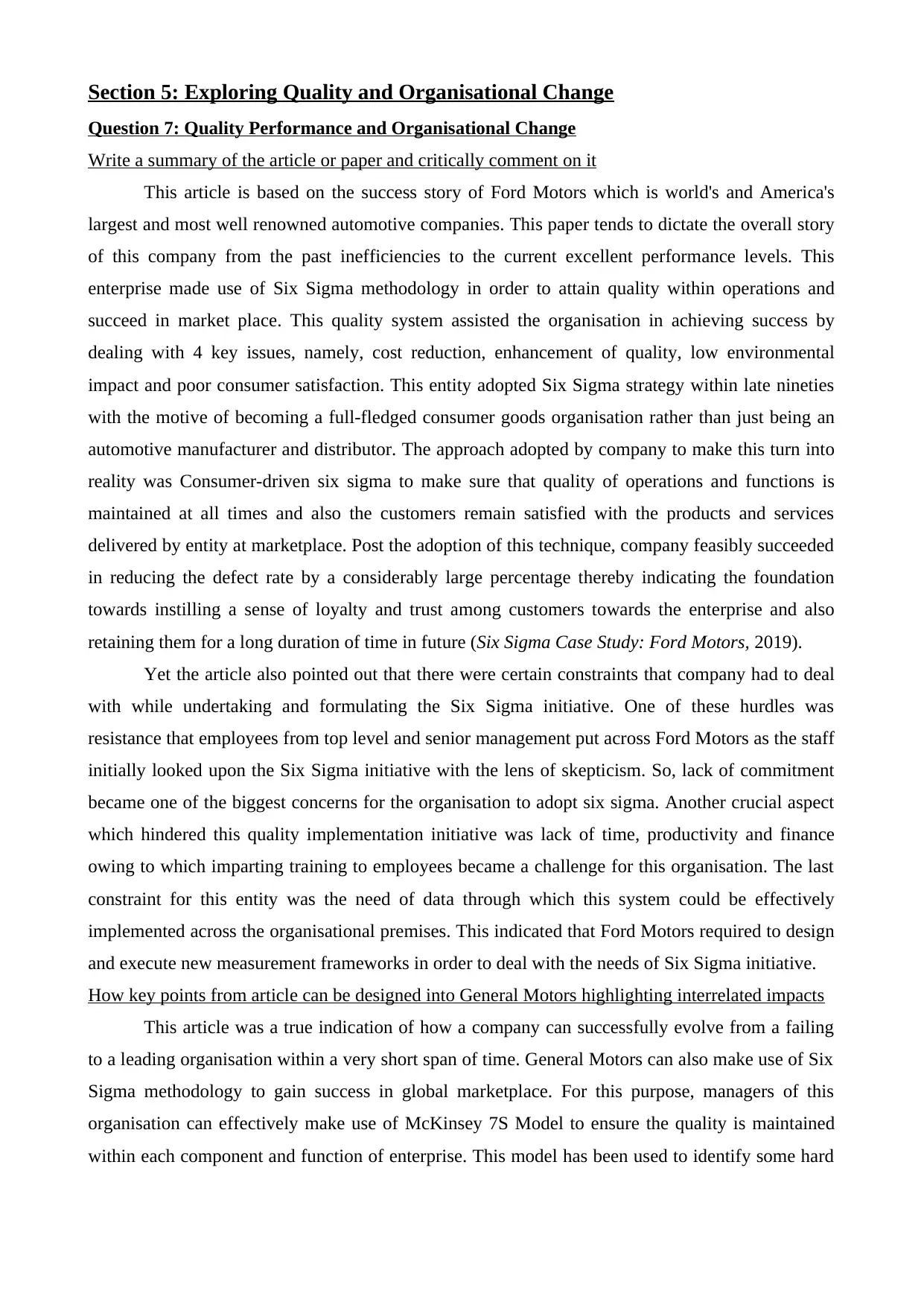
Section 5: Exploring Quality and Organisational Change
Question 7: Quality Performance and Organisational Change
Write a summary of the article or paper and critically comment on it
This article is based on the success story of Ford Motors which is world's and America's
largest and most well renowned automotive companies. This paper tends to dictate the overall story
of this company from the past inefficiencies to the current excellent performance levels. This
enterprise made use of Six Sigma methodology in order to attain quality within operations and
succeed in market place. This quality system assisted the organisation in achieving success by
dealing with 4 key issues, namely, cost reduction, enhancement of quality, low environmental
impact and poor consumer satisfaction. This entity adopted Six Sigma strategy within late nineties
with the motive of becoming a full-fledged consumer goods organisation rather than just being an
automotive manufacturer and distributor. The approach adopted by company to make this turn into
reality was Consumer-driven six sigma to make sure that quality of operations and functions is
maintained at all times and also the customers remain satisfied with the products and services
delivered by entity at marketplace. Post the adoption of this technique, company feasibly succeeded
in reducing the defect rate by a considerably large percentage thereby indicating the foundation
towards instilling a sense of loyalty and trust among customers towards the enterprise and also
retaining them for a long duration of time in future (Six Sigma Case Study: Ford Motors, 2019).
Yet the article also pointed out that there were certain constraints that company had to deal
with while undertaking and formulating the Six Sigma initiative. One of these hurdles was
resistance that employees from top level and senior management put across Ford Motors as the staff
initially looked upon the Six Sigma initiative with the lens of skepticism. So, lack of commitment
became one of the biggest concerns for the organisation to adopt six sigma. Another crucial aspect
which hindered this quality implementation initiative was lack of time, productivity and finance
owing to which imparting training to employees became a challenge for this organisation. The last
constraint for this entity was the need of data through which this system could be effectively
implemented across the organisational premises. This indicated that Ford Motors required to design
and execute new measurement frameworks in order to deal with the needs of Six Sigma initiative.
How key points from article can be designed into General Motors highlighting interrelated impacts
This article was a true indication of how a company can successfully evolve from a failing
to a leading organisation within a very short span of time. General Motors can also make use of Six
Sigma methodology to gain success in global marketplace. For this purpose, managers of this
organisation can effectively make use of McKinsey 7S Model to ensure the quality is maintained
within each component and function of enterprise. This model has been used to identify some hard
Question 7: Quality Performance and Organisational Change
Write a summary of the article or paper and critically comment on it
This article is based on the success story of Ford Motors which is world's and America's
largest and most well renowned automotive companies. This paper tends to dictate the overall story
of this company from the past inefficiencies to the current excellent performance levels. This
enterprise made use of Six Sigma methodology in order to attain quality within operations and
succeed in market place. This quality system assisted the organisation in achieving success by
dealing with 4 key issues, namely, cost reduction, enhancement of quality, low environmental
impact and poor consumer satisfaction. This entity adopted Six Sigma strategy within late nineties
with the motive of becoming a full-fledged consumer goods organisation rather than just being an
automotive manufacturer and distributor. The approach adopted by company to make this turn into
reality was Consumer-driven six sigma to make sure that quality of operations and functions is
maintained at all times and also the customers remain satisfied with the products and services
delivered by entity at marketplace. Post the adoption of this technique, company feasibly succeeded
in reducing the defect rate by a considerably large percentage thereby indicating the foundation
towards instilling a sense of loyalty and trust among customers towards the enterprise and also
retaining them for a long duration of time in future (Six Sigma Case Study: Ford Motors, 2019).
Yet the article also pointed out that there were certain constraints that company had to deal
with while undertaking and formulating the Six Sigma initiative. One of these hurdles was
resistance that employees from top level and senior management put across Ford Motors as the staff
initially looked upon the Six Sigma initiative with the lens of skepticism. So, lack of commitment
became one of the biggest concerns for the organisation to adopt six sigma. Another crucial aspect
which hindered this quality implementation initiative was lack of time, productivity and finance
owing to which imparting training to employees became a challenge for this organisation. The last
constraint for this entity was the need of data through which this system could be effectively
implemented across the organisational premises. This indicated that Ford Motors required to design
and execute new measurement frameworks in order to deal with the needs of Six Sigma initiative.
How key points from article can be designed into General Motors highlighting interrelated impacts
This article was a true indication of how a company can successfully evolve from a failing
to a leading organisation within a very short span of time. General Motors can also make use of Six
Sigma methodology to gain success in global marketplace. For this purpose, managers of this
organisation can effectively make use of McKinsey 7S Model to ensure the quality is maintained
within each component and function of enterprise. This model has been used to identify some hard
Secure Best Marks with AI Grader
Need help grading? Try our AI Grader for instant feedback on your assignments.
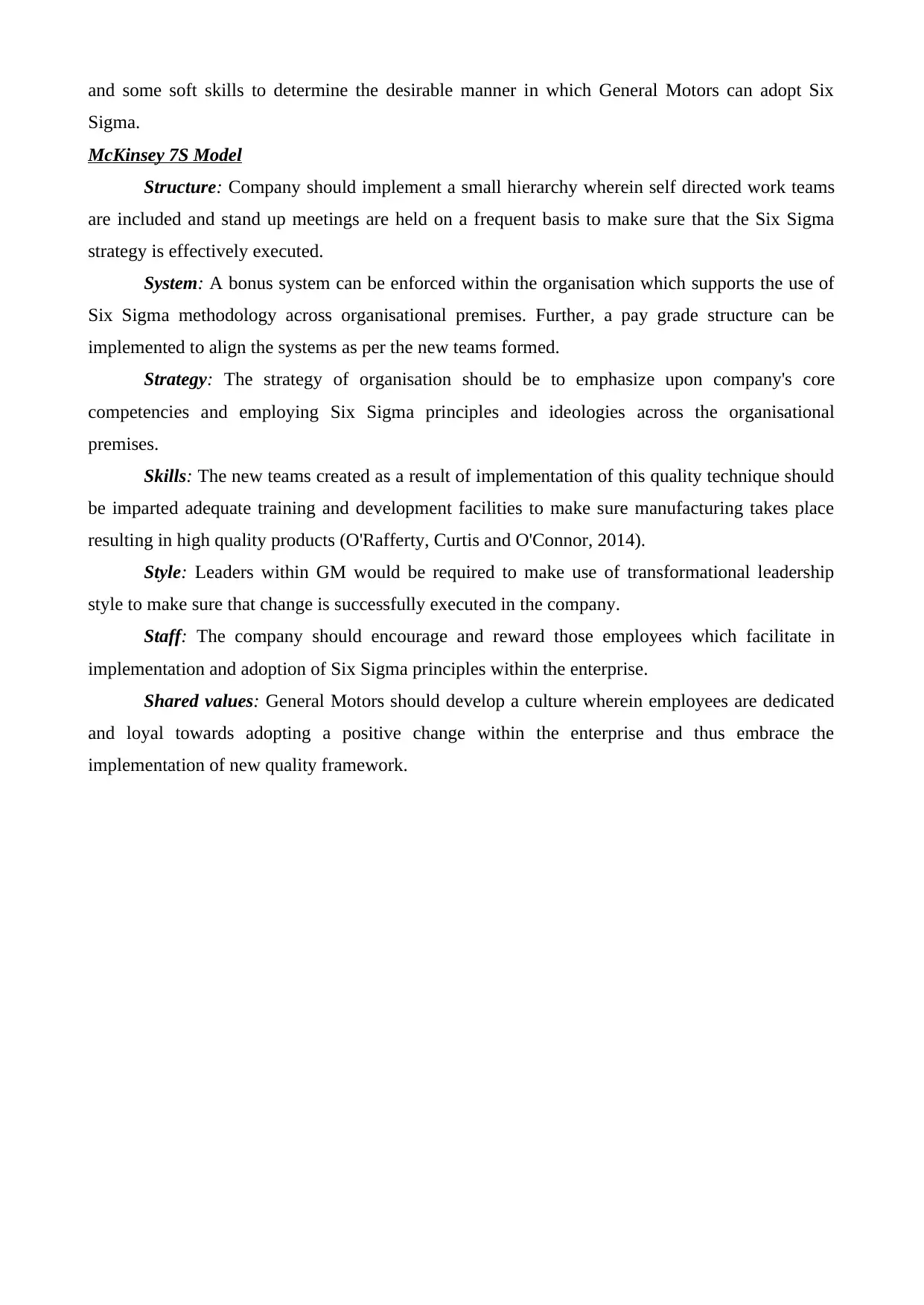
and some soft skills to determine the desirable manner in which General Motors can adopt Six
Sigma.
McKinsey 7S Model
Structure: Company should implement a small hierarchy wherein self directed work teams
are included and stand up meetings are held on a frequent basis to make sure that the Six Sigma
strategy is effectively executed.
System: A bonus system can be enforced within the organisation which supports the use of
Six Sigma methodology across organisational premises. Further, a pay grade structure can be
implemented to align the systems as per the new teams formed.
Strategy: The strategy of organisation should be to emphasize upon company's core
competencies and employing Six Sigma principles and ideologies across the organisational
premises.
Skills: The new teams created as a result of implementation of this quality technique should
be imparted adequate training and development facilities to make sure manufacturing takes place
resulting in high quality products (O'Rafferty, Curtis and O'Connor, 2014).
Style: Leaders within GM would be required to make use of transformational leadership
style to make sure that change is successfully executed in the company.
Staff: The company should encourage and reward those employees which facilitate in
implementation and adoption of Six Sigma principles within the enterprise.
Shared values: General Motors should develop a culture wherein employees are dedicated
and loyal towards adopting a positive change within the enterprise and thus embrace the
implementation of new quality framework.
Sigma.
McKinsey 7S Model
Structure: Company should implement a small hierarchy wherein self directed work teams
are included and stand up meetings are held on a frequent basis to make sure that the Six Sigma
strategy is effectively executed.
System: A bonus system can be enforced within the organisation which supports the use of
Six Sigma methodology across organisational premises. Further, a pay grade structure can be
implemented to align the systems as per the new teams formed.
Strategy: The strategy of organisation should be to emphasize upon company's core
competencies and employing Six Sigma principles and ideologies across the organisational
premises.
Skills: The new teams created as a result of implementation of this quality technique should
be imparted adequate training and development facilities to make sure manufacturing takes place
resulting in high quality products (O'Rafferty, Curtis and O'Connor, 2014).
Style: Leaders within GM would be required to make use of transformational leadership
style to make sure that change is successfully executed in the company.
Staff: The company should encourage and reward those employees which facilitate in
implementation and adoption of Six Sigma principles within the enterprise.
Shared values: General Motors should develop a culture wherein employees are dedicated
and loyal towards adopting a positive change within the enterprise and thus embrace the
implementation of new quality framework.
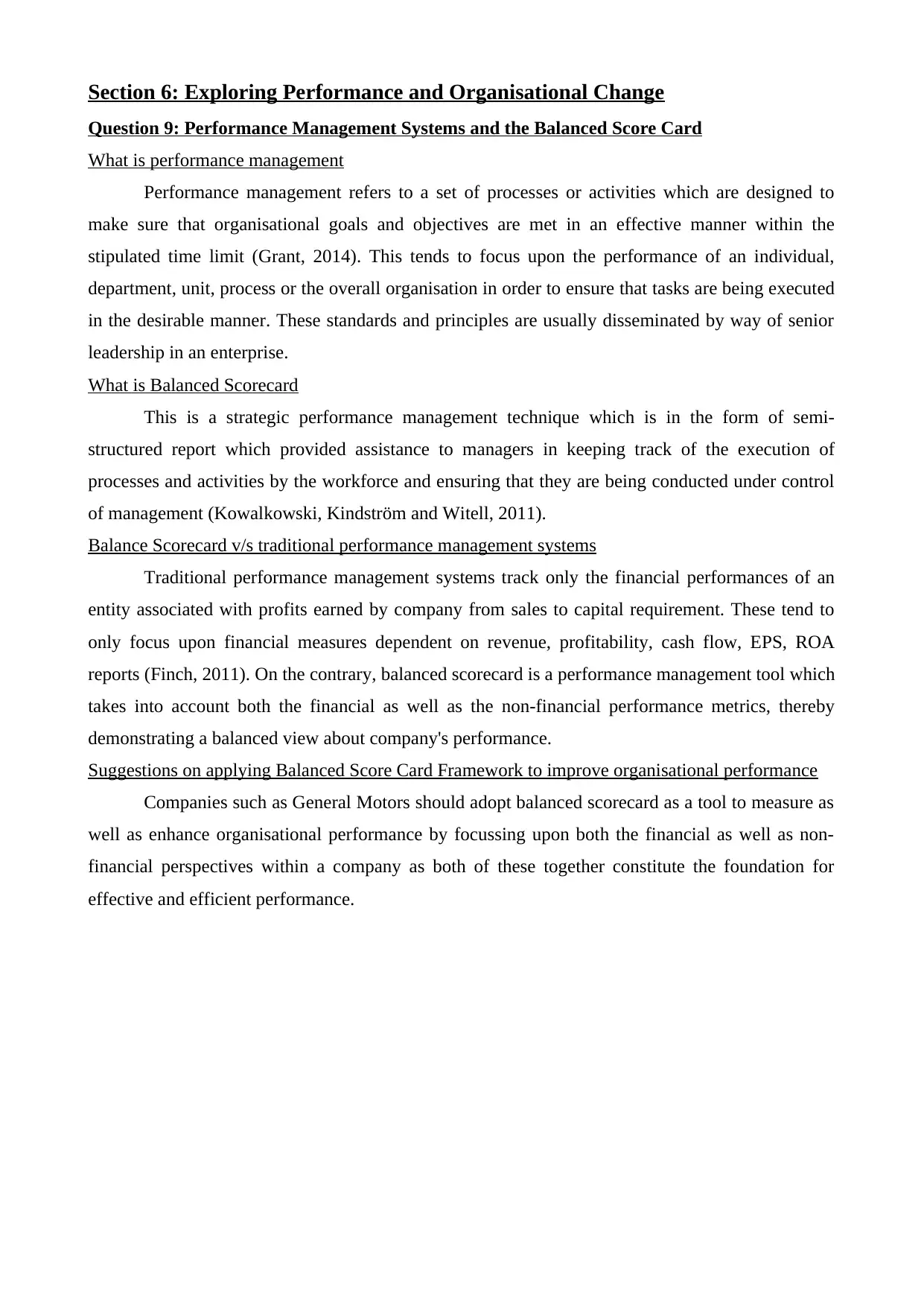
Section 6: Exploring Performance and Organisational Change
Question 9: Performance Management Systems and the Balanced Score Card
What is performance management
Performance management refers to a set of processes or activities which are designed to
make sure that organisational goals and objectives are met in an effective manner within the
stipulated time limit (Grant, 2014). This tends to focus upon the performance of an individual,
department, unit, process or the overall organisation in order to ensure that tasks are being executed
in the desirable manner. These standards and principles are usually disseminated by way of senior
leadership in an enterprise.
What is Balanced Scorecard
This is a strategic performance management technique which is in the form of semi-
structured report which provided assistance to managers in keeping track of the execution of
processes and activities by the workforce and ensuring that they are being conducted under control
of management (Kowalkowski, Kindström and Witell, 2011).
Balance Scorecard v/s traditional performance management systems
Traditional performance management systems track only the financial performances of an
entity associated with profits earned by company from sales to capital requirement. These tend to
only focus upon financial measures dependent on revenue, profitability, cash flow, EPS, ROA
reports (Finch, 2011). On the contrary, balanced scorecard is a performance management tool which
takes into account both the financial as well as the non-financial performance metrics, thereby
demonstrating a balanced view about company's performance.
Suggestions on applying Balanced Score Card Framework to improve organisational performance
Companies such as General Motors should adopt balanced scorecard as a tool to measure as
well as enhance organisational performance by focussing upon both the financial as well as non-
financial perspectives within a company as both of these together constitute the foundation for
effective and efficient performance.
Question 9: Performance Management Systems and the Balanced Score Card
What is performance management
Performance management refers to a set of processes or activities which are designed to
make sure that organisational goals and objectives are met in an effective manner within the
stipulated time limit (Grant, 2014). This tends to focus upon the performance of an individual,
department, unit, process or the overall organisation in order to ensure that tasks are being executed
in the desirable manner. These standards and principles are usually disseminated by way of senior
leadership in an enterprise.
What is Balanced Scorecard
This is a strategic performance management technique which is in the form of semi-
structured report which provided assistance to managers in keeping track of the execution of
processes and activities by the workforce and ensuring that they are being conducted under control
of management (Kowalkowski, Kindström and Witell, 2011).
Balance Scorecard v/s traditional performance management systems
Traditional performance management systems track only the financial performances of an
entity associated with profits earned by company from sales to capital requirement. These tend to
only focus upon financial measures dependent on revenue, profitability, cash flow, EPS, ROA
reports (Finch, 2011). On the contrary, balanced scorecard is a performance management tool which
takes into account both the financial as well as the non-financial performance metrics, thereby
demonstrating a balanced view about company's performance.
Suggestions on applying Balanced Score Card Framework to improve organisational performance
Companies such as General Motors should adopt balanced scorecard as a tool to measure as
well as enhance organisational performance by focussing upon both the financial as well as non-
financial perspectives within a company as both of these together constitute the foundation for
effective and efficient performance.
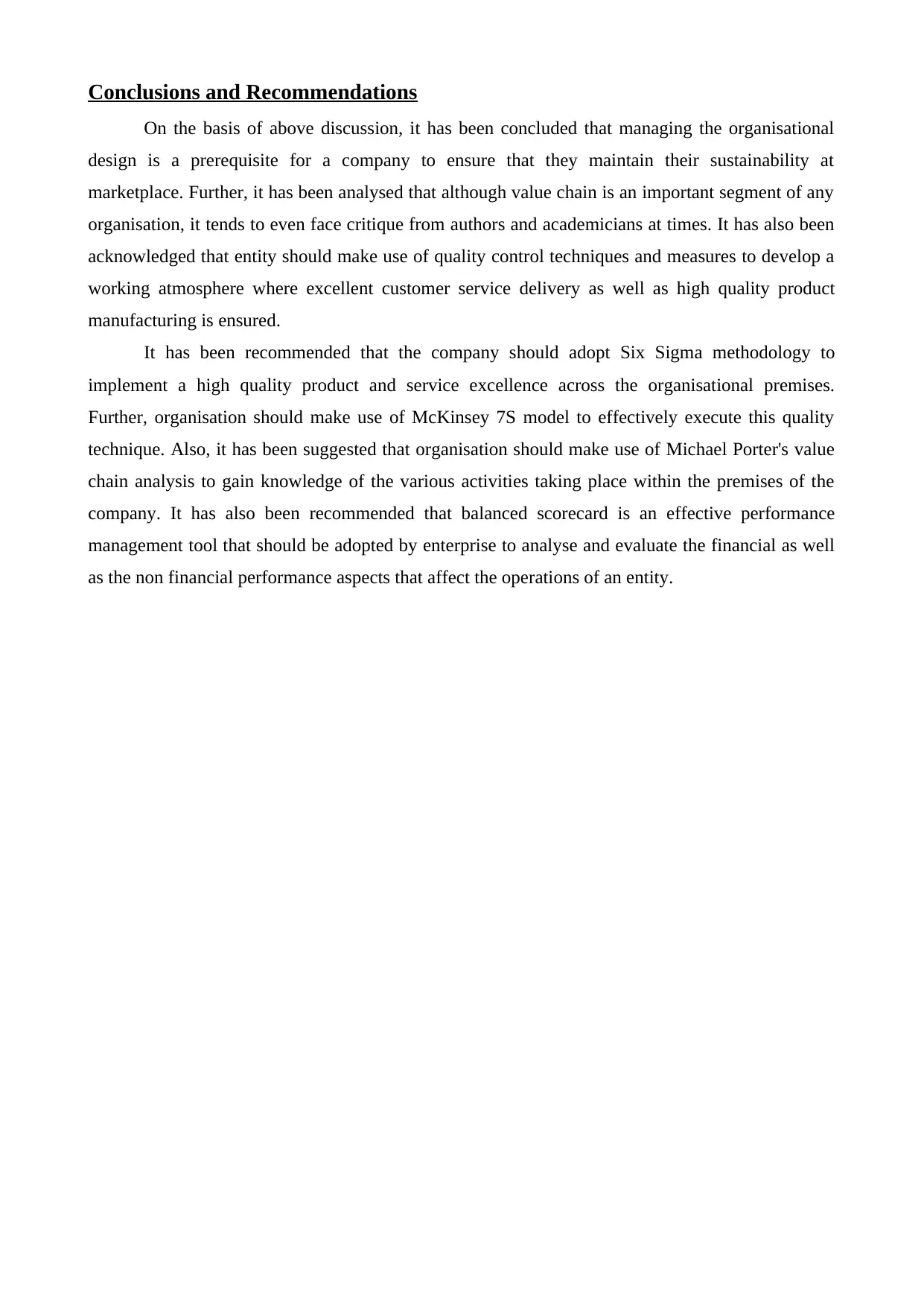
Conclusions and Recommendations
On the basis of above discussion, it has been concluded that managing the organisational
design is a prerequisite for a company to ensure that they maintain their sustainability at
marketplace. Further, it has been analysed that although value chain is an important segment of any
organisation, it tends to even face critique from authors and academicians at times. It has also been
acknowledged that entity should make use of quality control techniques and measures to develop a
working atmosphere where excellent customer service delivery as well as high quality product
manufacturing is ensured.
It has been recommended that the company should adopt Six Sigma methodology to
implement a high quality product and service excellence across the organisational premises.
Further, organisation should make use of McKinsey 7S model to effectively execute this quality
technique. Also, it has been suggested that organisation should make use of Michael Porter's value
chain analysis to gain knowledge of the various activities taking place within the premises of the
company. It has also been recommended that balanced scorecard is an effective performance
management tool that should be adopted by enterprise to analyse and evaluate the financial as well
as the non financial performance aspects that affect the operations of an entity.
On the basis of above discussion, it has been concluded that managing the organisational
design is a prerequisite for a company to ensure that they maintain their sustainability at
marketplace. Further, it has been analysed that although value chain is an important segment of any
organisation, it tends to even face critique from authors and academicians at times. It has also been
acknowledged that entity should make use of quality control techniques and measures to develop a
working atmosphere where excellent customer service delivery as well as high quality product
manufacturing is ensured.
It has been recommended that the company should adopt Six Sigma methodology to
implement a high quality product and service excellence across the organisational premises.
Further, organisation should make use of McKinsey 7S model to effectively execute this quality
technique. Also, it has been suggested that organisation should make use of Michael Porter's value
chain analysis to gain knowledge of the various activities taking place within the premises of the
company. It has also been recommended that balanced scorecard is an effective performance
management tool that should be adopted by enterprise to analyse and evaluate the financial as well
as the non financial performance aspects that affect the operations of an entity.
Paraphrase This Document
Need a fresh take? Get an instant paraphrase of this document with our AI Paraphraser
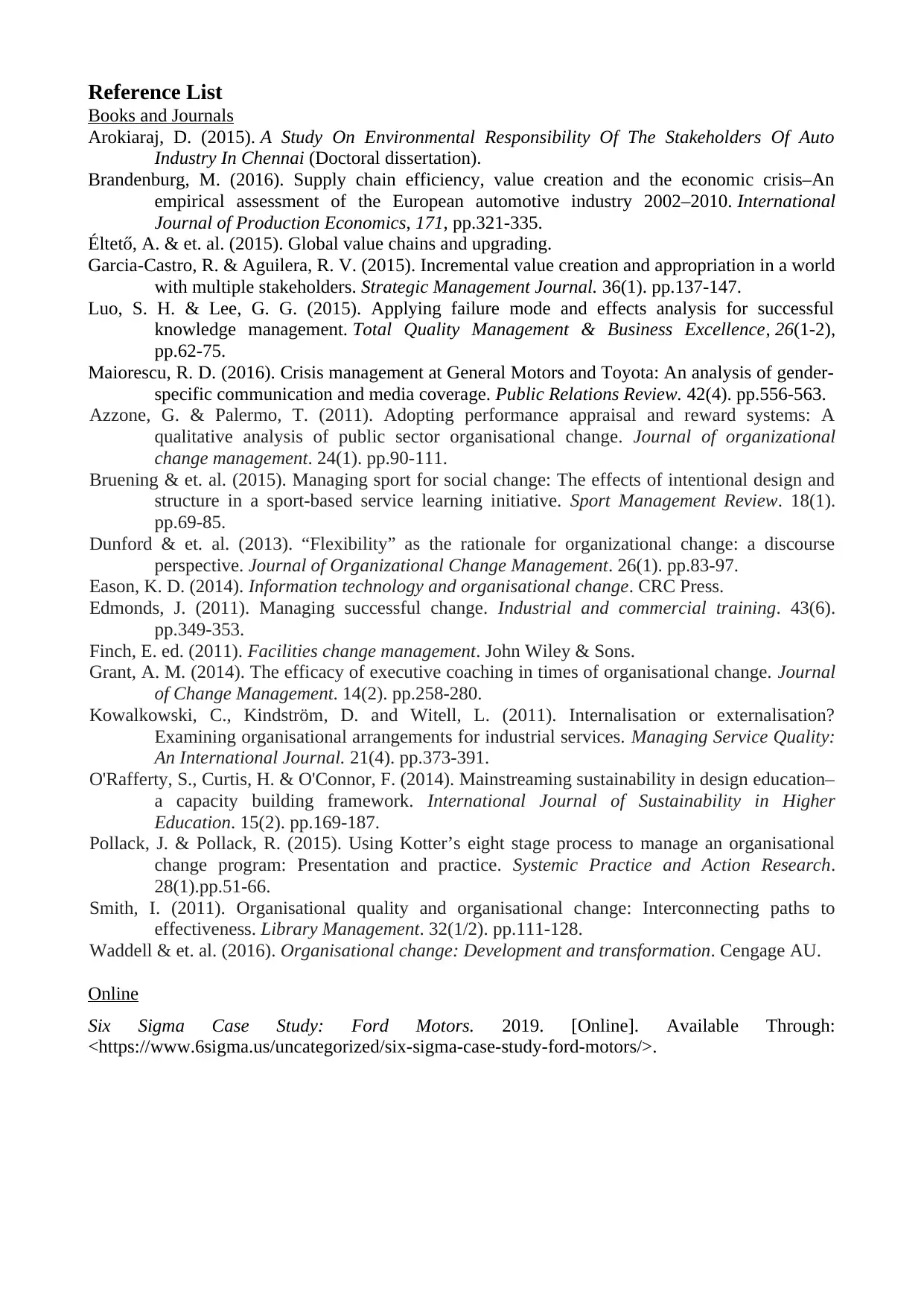
Reference List
Books and Journals
Arokiaraj, D. (2015). A Study On Environmental Responsibility Of The Stakeholders Of Auto
Industry In Chennai (Doctoral dissertation).
Brandenburg, M. (2016). Supply chain efficiency, value creation and the economic crisis–An
empirical assessment of the European automotive industry 2002–2010. International
Journal of Production Economics, 171, pp.321-335.
Éltető, A. & et. al. (2015). Global value chains and upgrading.
Garcia‐Castro, R. & Aguilera, R. V. (2015). Incremental value creation and appropriation in a world
with multiple stakeholders. Strategic Management Journal. 36(1). pp.137-147.
Luo, S. H. & Lee, G. G. (2015). Applying failure mode and effects analysis for successful
knowledge management. Total Quality Management & Business Excellence, 26(1-2),
pp.62-75.
Maiorescu, R. D. (2016). Crisis management at General Motors and Toyota: An analysis of gender-
specific communication and media coverage. Public Relations Review. 42(4). pp.556-563.
Azzone, G. & Palermo, T. (2011). Adopting performance appraisal and reward systems: A
qualitative analysis of public sector organisational change. Journal of organizational
change management. 24(1). pp.90-111.
Bruening & et. al. (2015). Managing sport for social change: The effects of intentional design and
structure in a sport-based service learning initiative. Sport Management Review. 18(1).
pp.69-85.
Dunford & et. al. (2013). “Flexibility” as the rationale for organizational change: a discourse
perspective. Journal of Organizational Change Management. 26(1). pp.83-97.
Eason, K. D. (2014). Information technology and organisational change. CRC Press.
Edmonds, J. (2011). Managing successful change. Industrial and commercial training. 43(6).
pp.349-353.
Finch, E. ed. (2011). Facilities change management. John Wiley & Sons.
Grant, A. M. (2014). The efficacy of executive coaching in times of organisational change. Journal
of Change Management. 14(2). pp.258-280.
Kowalkowski, C., Kindström, D. and Witell, L. (2011). Internalisation or externalisation?
Examining organisational arrangements for industrial services. Managing Service Quality:
An International Journal. 21(4). pp.373-391.
O'Rafferty, S., Curtis, H. & O'Connor, F. (2014). Mainstreaming sustainability in design education–
a capacity building framework. International Journal of Sustainability in Higher
Education. 15(2). pp.169-187.
Pollack, J. & Pollack, R. (2015). Using Kotter’s eight stage process to manage an organisational
change program: Presentation and practice. Systemic Practice and Action Research.
28(1).pp.51-66.
Smith, I. (2011). Organisational quality and organisational change: Interconnecting paths to
effectiveness. Library Management. 32(1/2). pp.111-128.
Waddell & et. al. (2016). Organisational change: Development and transformation. Cengage AU.
Online
Six Sigma Case Study: Ford Motors. 2019. [Online]. Available Through:
<https://www.6sigma.us/uncategorized/six-sigma-case-study-ford-motors/>.
Books and Journals
Arokiaraj, D. (2015). A Study On Environmental Responsibility Of The Stakeholders Of Auto
Industry In Chennai (Doctoral dissertation).
Brandenburg, M. (2016). Supply chain efficiency, value creation and the economic crisis–An
empirical assessment of the European automotive industry 2002–2010. International
Journal of Production Economics, 171, pp.321-335.
Éltető, A. & et. al. (2015). Global value chains and upgrading.
Garcia‐Castro, R. & Aguilera, R. V. (2015). Incremental value creation and appropriation in a world
with multiple stakeholders. Strategic Management Journal. 36(1). pp.137-147.
Luo, S. H. & Lee, G. G. (2015). Applying failure mode and effects analysis for successful
knowledge management. Total Quality Management & Business Excellence, 26(1-2),
pp.62-75.
Maiorescu, R. D. (2016). Crisis management at General Motors and Toyota: An analysis of gender-
specific communication and media coverage. Public Relations Review. 42(4). pp.556-563.
Azzone, G. & Palermo, T. (2011). Adopting performance appraisal and reward systems: A
qualitative analysis of public sector organisational change. Journal of organizational
change management. 24(1). pp.90-111.
Bruening & et. al. (2015). Managing sport for social change: The effects of intentional design and
structure in a sport-based service learning initiative. Sport Management Review. 18(1).
pp.69-85.
Dunford & et. al. (2013). “Flexibility” as the rationale for organizational change: a discourse
perspective. Journal of Organizational Change Management. 26(1). pp.83-97.
Eason, K. D. (2014). Information technology and organisational change. CRC Press.
Edmonds, J. (2011). Managing successful change. Industrial and commercial training. 43(6).
pp.349-353.
Finch, E. ed. (2011). Facilities change management. John Wiley & Sons.
Grant, A. M. (2014). The efficacy of executive coaching in times of organisational change. Journal
of Change Management. 14(2). pp.258-280.
Kowalkowski, C., Kindström, D. and Witell, L. (2011). Internalisation or externalisation?
Examining organisational arrangements for industrial services. Managing Service Quality:
An International Journal. 21(4). pp.373-391.
O'Rafferty, S., Curtis, H. & O'Connor, F. (2014). Mainstreaming sustainability in design education–
a capacity building framework. International Journal of Sustainability in Higher
Education. 15(2). pp.169-187.
Pollack, J. & Pollack, R. (2015). Using Kotter’s eight stage process to manage an organisational
change program: Presentation and practice. Systemic Practice and Action Research.
28(1).pp.51-66.
Smith, I. (2011). Organisational quality and organisational change: Interconnecting paths to
effectiveness. Library Management. 32(1/2). pp.111-128.
Waddell & et. al. (2016). Organisational change: Development and transformation. Cengage AU.
Online
Six Sigma Case Study: Ford Motors. 2019. [Online]. Available Through:
<https://www.6sigma.us/uncategorized/six-sigma-case-study-ford-motors/>.

Appendices
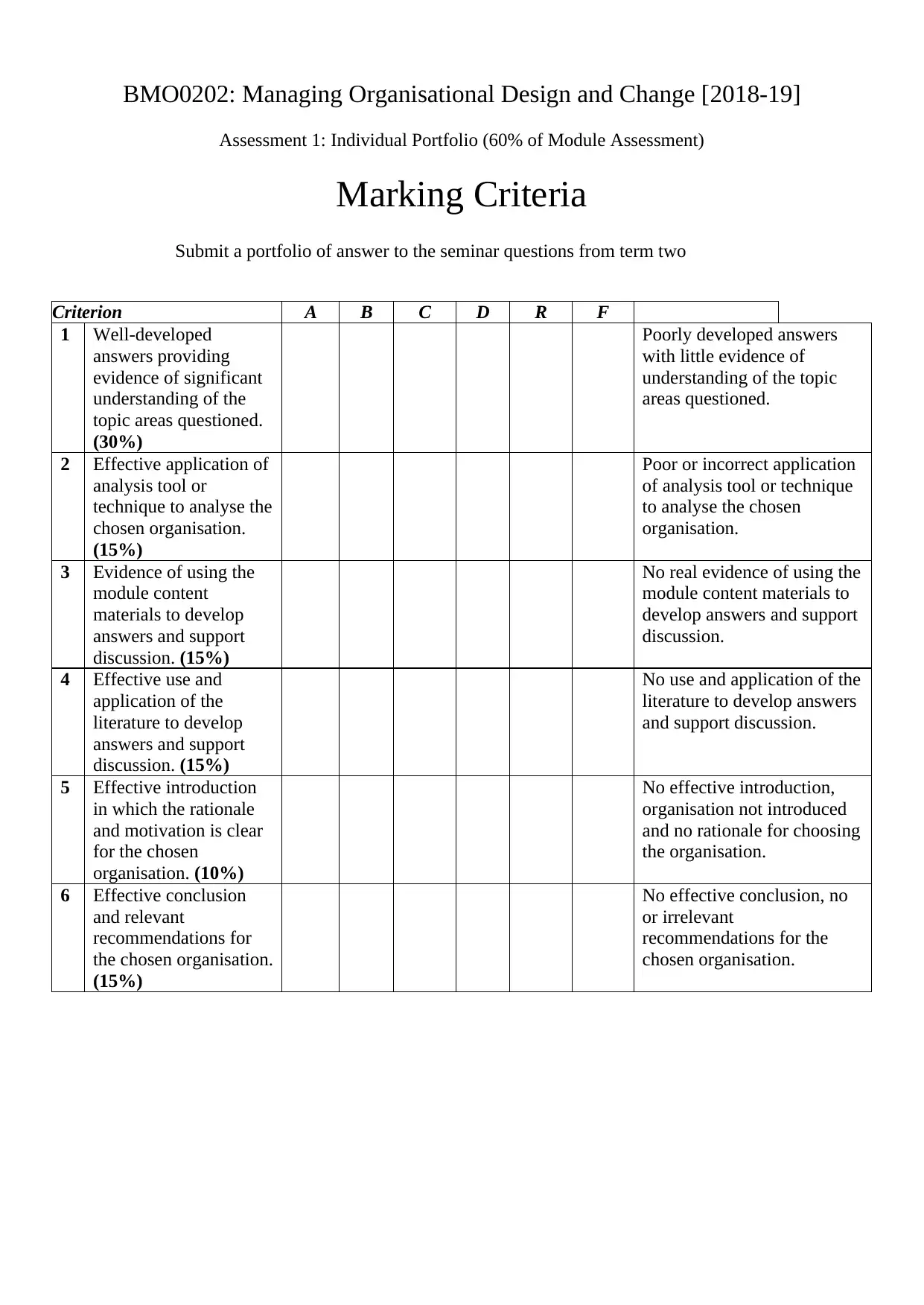
BMO0202: Managing Organisational Design and Change [2018-19]
Assessment 1: Individual Portfolio (60% of Module Assessment)
Marking Criteria
Submit a portfolio of answer to the seminar questions from term two
Criterion A B C D R F
1 Well-developed
answers providing
evidence of significant
understanding of the
topic areas questioned.
(30%)
Poorly developed answers
with little evidence of
understanding of the topic
areas questioned.
2 Effective application of
analysis tool or
technique to analyse the
chosen organisation.
(15%)
Poor or incorrect application
of analysis tool or technique
to analyse the chosen
organisation.
3 Evidence of using the
module content
materials to develop
answers and support
discussion. (15%)
No real evidence of using the
module content materials to
develop answers and support
discussion.
4 Effective use and
application of the
literature to develop
answers and support
discussion. (15%)
No use and application of the
literature to develop answers
and support discussion.
5 Effective introduction
in which the rationale
and motivation is clear
for the chosen
organisation. (10%)
No effective introduction,
organisation not introduced
and no rationale for choosing
the organisation.
6 Effective conclusion
and relevant
recommendations for
the chosen organisation.
(15%)
No effective conclusion, no
or irrelevant
recommendations for the
chosen organisation.
Assessment 1: Individual Portfolio (60% of Module Assessment)
Marking Criteria
Submit a portfolio of answer to the seminar questions from term two
Criterion A B C D R F
1 Well-developed
answers providing
evidence of significant
understanding of the
topic areas questioned.
(30%)
Poorly developed answers
with little evidence of
understanding of the topic
areas questioned.
2 Effective application of
analysis tool or
technique to analyse the
chosen organisation.
(15%)
Poor or incorrect application
of analysis tool or technique
to analyse the chosen
organisation.
3 Evidence of using the
module content
materials to develop
answers and support
discussion. (15%)
No real evidence of using the
module content materials to
develop answers and support
discussion.
4 Effective use and
application of the
literature to develop
answers and support
discussion. (15%)
No use and application of the
literature to develop answers
and support discussion.
5 Effective introduction
in which the rationale
and motivation is clear
for the chosen
organisation. (10%)
No effective introduction,
organisation not introduced
and no rationale for choosing
the organisation.
6 Effective conclusion
and relevant
recommendations for
the chosen organisation.
(15%)
No effective conclusion, no
or irrelevant
recommendations for the
chosen organisation.
1 out of 19
![[object Object]](/_next/static/media/star-bottom.7253800d.svg)





